Types of lighting fixtures are all familiar incandescent lamps. Types of artificial lighting - street, facade, landscape, and types of lamps used
The impression of the interior of a room largely depends on the kind of lighting in it. Good furniture, accessories and decorative elements are not enough. Well-chosen lighting can highlight the advantages of the interior, highlight functional areas, and place accents. In a room where the lighting is well thought out, a pleasant atmosphere is felt, the mood is transmitted to those who are in this room.
All types of lamps can be divided into large groups depending on the light source - light rays can be reflected, diffused or directed. Moreover, among pendant lamps, floor lamps and slots there may be those that can be classified as any type.
Lighting devices can also be divided into groups according to the type of mounting, the power of the lamps, the type of lamps used, as well as their number.
So, it’s worth understanding each type in more detail. lighting fixtures
A pendant lamp is characterized by mounting light sources at a certain distance from the ceiling. The most important advantage of this type of lighting is the ability to change the height at which it will hang. This feature is good for rooms where the ceilings are low or have non-standard heights. Manufacturers of pendant lamps offer a very wide range of designs and materials for the manufacture of pendant lamps (glass, wood, ceramics, plastic, crystal). Pendant lamps will be used in the bedroom, living room, kitchen, children's room and office. Classic examples A pendant lamp can be called a chandelier with several arms.
The peculiarity of recessed lamps is that separate element the design may cover part of the lamp or all of it. They are mounted in furniture, floors, ceilings, walls. They come in two types:
- Recessed spotlights (these are standard fixtures).
- Panel recessed luminaires.
Built-in lamps can emit light in a narrow directional stream or diffuse it throughout the room. This type of lamp is often used in home lighting.
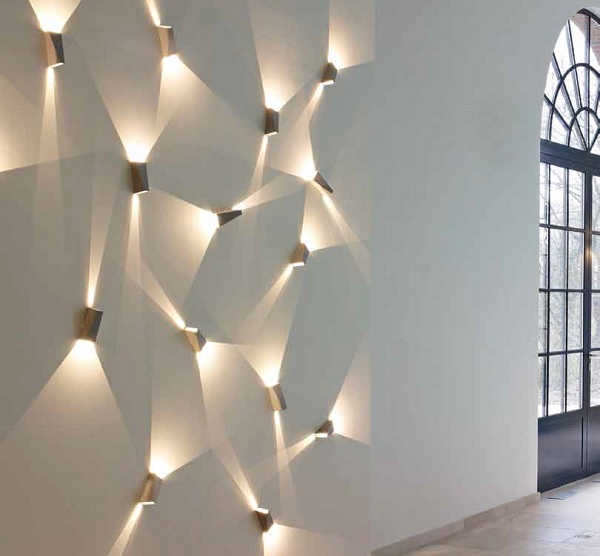
A spotlight is small in size, but it can emit a powerful beam of light aimed at a specific area. Such lighting is often used where suspended ceilings are installed. They are mounted into furniture to provide decorative lighting and are often seen in display cases and other retail fixtures. In houses Spotlights successfully installed in kitchen cabinets, for lighting a desktop, in closets and dressing rooms, in rooms, to provide lighting for individual areas.
In such a lamp, the light source can be a halogen or reflector lamp. Spotlights are suitable for installation in tension, pendant or slatted ceilings. The design of spotlights is very convenient, in which you can change the direction of the flow of light rays.
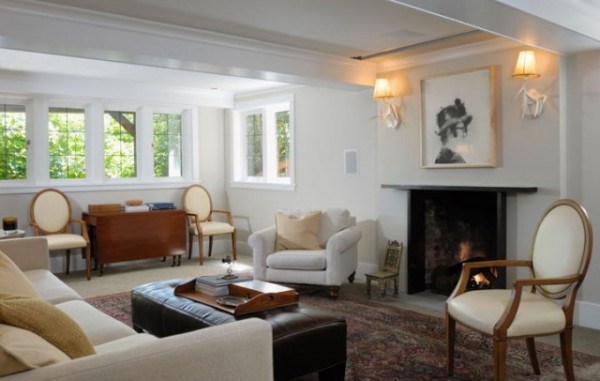
This lighting device is considered an additional source of lighting. It finds application in any room: office, hallway, bedroom, living room, children's room and even bathroom. It is advisable to select these lamps in the same design as the main source of lighting. The light source in such lamps can be the most different lamps. For the manufacture of such lamps are used various materials: glass (frosted and transparent), plastic, wood, textiles, and there are also wall lamps for pompous living rooms with crystal pendants.
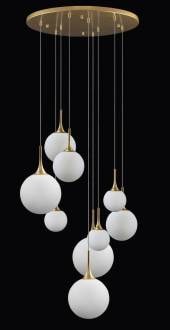
In fact, this is the table lamp we all know. This type of lighting device carries the maximum functional load. Moreover, such a lamp can be a real accent in interior design. Table lamps can find a place in the house not only on the desktop, but also on the bedside tables near the bed in the bedroom for reading.
Today, table lamps are designed with maximum comfort in mind - they have flexible legs that can be adjusted to any height and angle. They have a reliable fastening of the case to the tabletop. The light source can be different lamps, but it is preferable to use those that provide light as close as possible to the daylight spectrum.
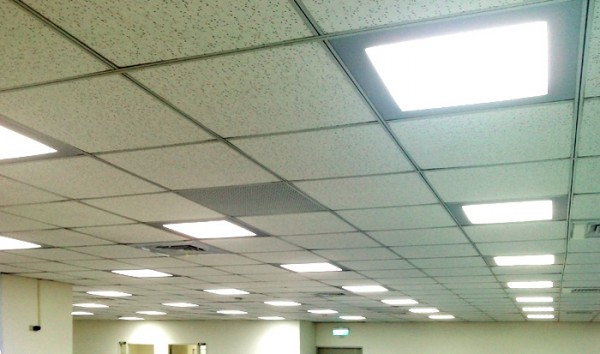
Such lamps are mounted directly into the suspended ceiling. Their size is ideally adjusted to be mounted on a suspended structure. The convenience of this lighting device is that light sources can be placed exactly in the place where it is most needed. In offices, such lamps are installed directly above the desktop.
This type of lamps is powered by fluorescent lamps that provide directional light. This feature makes it necessary to install several devices in one room to ensure uniform lighting throughout the entire area.
The appearance of the panel ceiling light resembles a box. The design of the lamp includes a reflector and a diffuser.
This type of lamps is very functional; it does not carry any additional decorative load. But even here, designers sometimes offer non-standard solutions. Such lamps are used in in public places, shops, in the house, such a lamp will find a place in the corridor, on the stairs or in the garage.
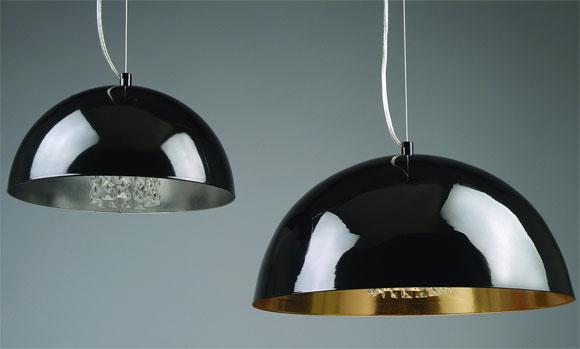
This type of lighting fixture can be called the simplest in design. A pendant lamp is not a chandelier; it has only one light source. The lamp has one mount to the ceiling in the form of a thin suspension, onto which a lampshade (or diffuser) is attached, as well as a socket. This type of lamps is made from the most different materials: plastic, paper, wood, textiles, glass, ceramics and so on. The light source most often is ordinary incandescent lamps, halogen lamps and many other types of lamps. This type of lamps is suitable for lighting the kitchen, corridor, bedroom and nursery.
A significant disadvantage of such a lamp is the impossibility of using it in rooms with low ceilings. Single-lamp lamps are sometimes mounted in whole groups of several pieces in order to achieve optimal level illumination, as well as to create a light accent in the interior.
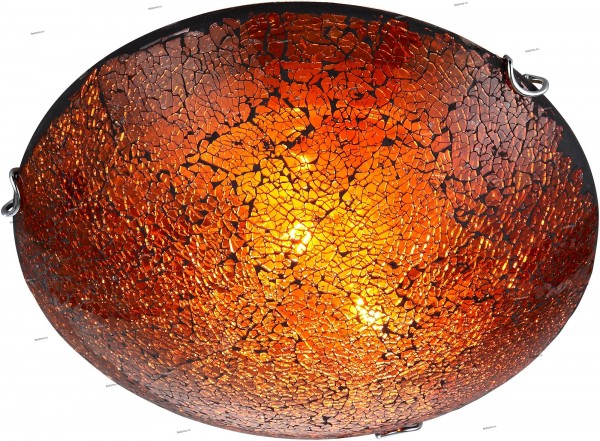
This type of lighting fixture has the peculiarity of being mounted directly to the ceiling. The light source in such a lamp is partially or completely covered by a diffuser. The convenience of the ceiling lamp is its compactness, as well as ease of installation. Such lighting fixtures are suitable in places where the ceiling is low and a regular chandelier would be in the way.
Ceiling lamps most often have a laconic design, so they are applicable in the most different interiors. Since they have small sizes, then such lamps will help preserve free space over your head. Optimal ceiling lamps Suitable for use in bathrooms, corridors, children's rooms, hallways, kitchens, corridors and bedrooms. It is especially convenient to install lampshades in a children's room, because children, while playing, throw objects or shake out blankets so that chandeliers with protruding parts can break. To illuminate several zones at once, mini-shades are suitable, which can be positioned over different functional areas.
The production of newfangled lighting devices on suspensions has received the greatest development in countries such as Belgium (Massive), Germany (SLV, Dlits), Austria (Globo), Italy...
Wall lamps are lighting devices designed to be attached to a vertical surface using a special system. This type of lamp will decorate any...
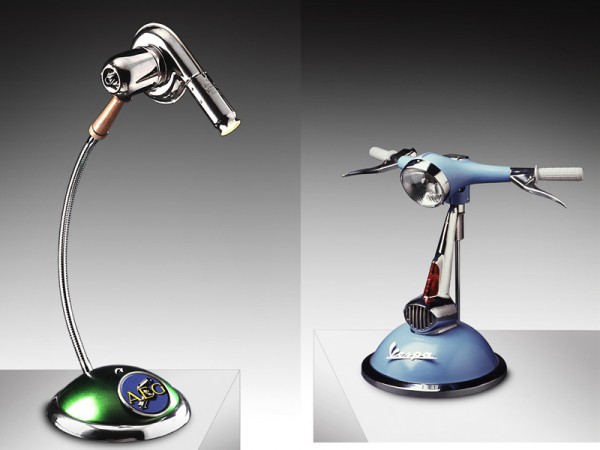
Modern table lamps are designed not only to illuminate a certain area in the room, but also to add to its atmosphere special style which is achieved carefully...
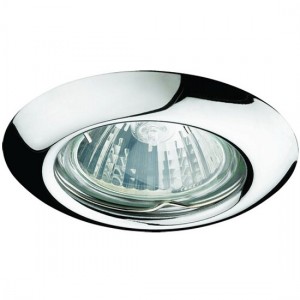
For the design of any room, one of the most significant components remains the organization of lighting. Depending on how carefully the lighting is designed, you can...
Working and emergency lighting in all rooms, workplaces, open spaces ahs and streets must provide illumination in accordance with established requirements.
Work and emergency lighting fixtures used during the operation of electrical installations must only be factory-made and comply with the requirements state standards and technical conditions.
Emergency lighting fixtures must be distinguished from task lighting fixtures by signs or coloring.
Light barrier chimneys and other high structures must comply with established rules.
Emergency and work lighting fixtures must be powered from independent sources. When working lighting is turned off, switching to emergency lighting should occur automatically or manually, according to design decisions, based on the feasibility of local conditions and in accordance with the requirements of electrical installation rules.
Power supply to the emergency lighting network according to circuits other than the design ones is not allowed.
Connecting portable transformers and other types of loads not related to this lighting to the emergency lighting network is not permitted.
The emergency lighting network must be made without plug sockets.
On front side switchboards and assemblies of the lighting network must have inscriptions (markings) indicating the name (panel or assembly), number corresponding to the dispatch name. WITH inside(for example, on doors) must be single line diagram, inscriptions indicating the current value of the fuse link on the fuses or rated current automatic switches and the names of electrical receivers, respectively, receiving power through them. Circuit breakers must
ensure selectivity of disconnection of consumers receiving power from them.
The use of lighting networks to connect any portable or mobile electrical receivers is not permitted.
For powering portable (hand-held) electric lamps in high-risk areas and especially hazardous areas A voltage of no higher than 50 V should be used, and when working in particularly unfavorable conditions and in outdoor installations - no higher than 12 V.
Plugs from 12-50 V appliances should not fit into outlets with a higher voltage rating. In rooms where voltage of two or more ratings is used, at all plug sockets there must be inscriptions indicating rated voltage.
The use of autotransformers to power 12-50 V network lamps is not permitted.
The use of fluorescent lamps that are not mounted on rigid supports for portable lighting is not permitted.
The installation of lamps in the luminaires of the working and emergency lighting network, the power or color of the radiation of which does not correspond to the design, as well as the removal of diffusers, shielding and protective grilles of luminaires is not allowed.
2.12.8. Power supply of internal, external, and security lighting networks of Consumers, buildings, residential and public buildings, open spaces and streets, as a rule, should be provided on separate lines.
Management of the outdoor lighting network, except for the lighting network of remote objects, as well as control of the security lighting network should, as a rule, be carried out centrally from the energy management panel room of a given Consumer or other special room.
2.12.9. The lighting network must receive power from sources (stabilizers or separate transformers) that ensure the ability to maintain voltage within the required limits.
The voltage on the lamps should not be higher than the rated value. The voltage drop at the most remote lamps of the internal working lighting network, as well as floodlight installations, should be no more than 5% of the rated voltage; for the most remote lamps of the external and emergency lighting network and in the 12-50 V network - no more than 10%.
2.12.10. In the corridors of electrical substations and distribution devices, having two exits, and in passage tunnels the lighting must be made with two-way control.
2.12.11. Operating personnel servicing electrical lighting networks must have diagrams of this network, a supply of calibrated inserts, appropriate lamps and lamps of all voltages of this lighting network.
Operating and maintenance personnel of the Consumer or facility, even in the presence of emergency lighting, must be equipped with portable electric flashlights with autonomous power supply.
2.12.12. Cleaning of lamps, inspection and repair of the electric lighting network must be carried out according to a schedule (pre-operation plan) by qualified personnel.
Frequency of work on cleaning lamps and checking the technical condition of the Consumer’s lighting installations (presence and integrity of glass, grilles and meshes, serviceability of lamp seals special purpose etc.) must be installed by the person responsible for the Consumer’s electrical equipment, taking into account local conditions. In areas subject to increased contamination, cleaning of luminaires should be carried out according to a special schedule.
2.12.13. Replacement of burnt-out lamps can be done in a group or individual way, which is set specifically for each Consumer, depending on the availability of lamps and the power of the lighting installation. With the group method, the timing of the next cleaning of the fittings should coincide with the timing of the group replacement of lamps.
2.12.14. When the hanging height of lamps is up to 5 m, they can be serviced from ladders and stepladders. If the luminaires are located at a higher height, they may be serviced from overhead cranes, stationary bridges and mobile devices, subject to the safety measures established by the safety rules for the operation of electrical installations and local instructions.
2.12.15. Failed fluorescent lamps, DRL lamps and other sources containing mercury must be stored in a special room. They must be periodically removed for destruction and decontamination to designated areas.
2.12.16. Inspection and testing of the lighting network should be carried out within the following periods: checking the serviceability of emergency lighting when the working lighting is turned off - 2 times a year;
measurement of indoor illumination (including areas, individual workplaces, passages, etc.) - when putting the network into operation in accordance with illumination standards, as well as when changing functional purpose premises.
2.12.17. Checking the condition of stationary equipment and electrical wiring of emergency and work lighting, testing and measuring the insulation resistance of wires, cables and grounding devices must be carried out when putting the electric lighting network into operation, and subsequently according to a schedule approved by the person responsible for the electrical equipment of the Consumer, but at least once every three years. The measurement results are documented in a report (protocol) in accordance with the electrical equipment testing standards (Appendix 3).
If you are planning to renovate an apartment or private house, you should think in advance about the lighting tactics for each room. For a suburban building, it is also advisable to consider new possibilities for lighting the area. You can, for example, use lamps operating on solar powered.
The market offers wide choose a variety of lighting devices designed to illuminate rooms and areas. Spotlights
If speak about modern approach When it comes to lighting rooms, you should remember about built-in (also known as spotlights) lamps. According to experts, they are most appropriate on suspended ceilings, since you need a small space where you can place the “body” of the spotlight. But sometimes they are built into furniture or walls, and when arranging street lighting installed in pedestrian paths. 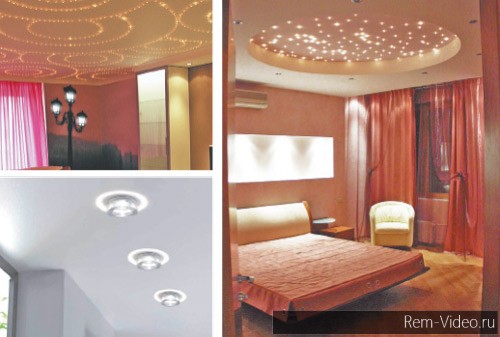 Of course, street lamps have shockproof properties. They are installed not only on hiking trails, but also on roads on which cars drive in a closed area (for example, inside a private property). Experts believe that this method of lighting the route is quite effective. And it’s easier to change light bulbs - you don’t need to climb on poles.
Of course, street lamps have shockproof properties. They are installed not only on hiking trails, but also on roads on which cars drive in a closed area (for example, inside a private property). Experts believe that this method of lighting the route is quite effective. And it’s easier to change light bulbs - you don’t need to climb on poles. 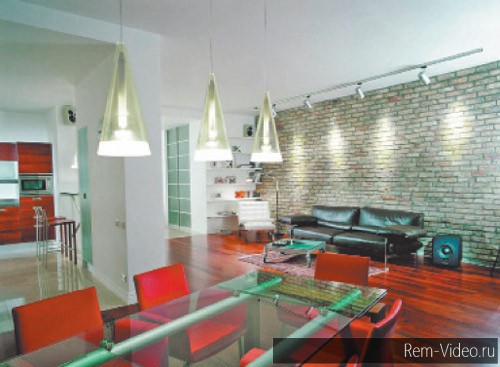 According to experts, spotlights are not only modern, but also profitable if you install energy-saving light bulbs in them. Built-in lights illuminate the room evenly if they are placed at the same distance from each other. Thus, despite the economical energy consumption, the efficiency of spotlights can be greater than that of a chandelier located in the center of the room. However, central lighting room with a large lamp or chandelier harmonizes perfectly with the “starry sky” of the built-in lamps. Often spotlights are built around the perimeter of the ceiling, while a chandelier is placed in the middle. Spotlights also go well with side lighting, but all lighting fixtures must be in harmony with each other.
According to experts, spotlights are not only modern, but also profitable if you install energy-saving light bulbs in them. Built-in lights illuminate the room evenly if they are placed at the same distance from each other. Thus, despite the economical energy consumption, the efficiency of spotlights can be greater than that of a chandelier located in the center of the room. However, central lighting room with a large lamp or chandelier harmonizes perfectly with the “starry sky” of the built-in lamps. Often spotlights are built around the perimeter of the ceiling, while a chandelier is placed in the middle. Spotlights also go well with side lighting, but all lighting fixtures must be in harmony with each other. 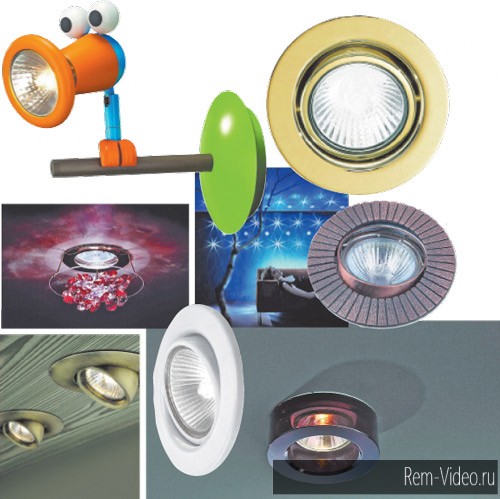 Built-in lamps come in round and square. According to experts, in Lately More and more decorative built-in lamps are appearing. Designers give preference to lamps with an original external frame. Typically, miniature lighting fixtures are selected in such a way that their decor is in harmony with ceiling trim or cornices. Track systems
Built-in lamps come in round and square. According to experts, in Lately More and more decorative built-in lamps are appearing. Designers give preference to lamps with an original external frame. Typically, miniature lighting fixtures are selected in such a way that their decor is in harmony with ceiling trim or cornices. Track systems
Track systems are a series of light bulbs suspended on one or more rails. The track not only serves as a suspension device in the form of a rigid guide or tension “rope,” but also contains electrical wiring “in the body.” In particular, tracks are used for lighting large premises with high ceilings, on which it is impractical to install a lighting system - the lamps will be too far away from the people in the room. To make the light from bulbs more effective, you need to bring it closer. Of course, lamps can be hung on long cords, rods or chains, but there is a limit to everything. Optimal proximity of lighting fixtures can be achieved, for example, using tracks that are mounted on opposite walls. Often in such track systems, lamps are fixed with the ability to move along the track. The maneuverability of the lamps allows you to achieve the most efficient lighting a given area. The length of the tracks can be more than 10 meters, which allows you to stretch the track from wall to wall in very spacious rooms. 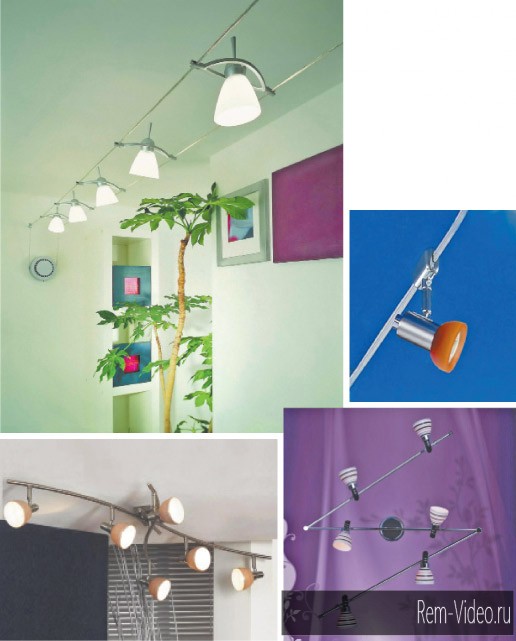 There are other types of track systems when the tracks are mounted only on the ceiling or wall. In particular, to secure a series of light bulbs, a rigid base is used in which wires are laid. Such tracks are much shorter than long flexible track systems, however, from each element of a “rigid” track you can create a system of any configuration, including a very long one. Important property track system is that light bulbs mounted on one track can be rotated in different directions, adjusting the direction of light depending on the need. “Prefabricated” track systems are convenient in that each element can be installed at any angle to the floor, thus choosing the most advantageous angle for illuminating paintings or sculptures. Maneuverable lighting is convenient for exhibition halls and art galleries. And in apartments filled with art objects or other decorative elements that make sense to consider, it is also advisable to hang a track system that will accurately illuminate several objects at once. According to experts, track systems are good not only for targeted lighting, but also for decorating interiors in high-tech or modern style. The use of flexible tracks, when one end is fixed to the floor and the other to the ceiling, looks especially original. Lamps designed in a certain style are hung along a vertical guide. Chandeliers
There are other types of track systems when the tracks are mounted only on the ceiling or wall. In particular, to secure a series of light bulbs, a rigid base is used in which wires are laid. Such tracks are much shorter than long flexible track systems, however, from each element of a “rigid” track you can create a system of any configuration, including a very long one. Important property track system is that light bulbs mounted on one track can be rotated in different directions, adjusting the direction of light depending on the need. “Prefabricated” track systems are convenient in that each element can be installed at any angle to the floor, thus choosing the most advantageous angle for illuminating paintings or sculptures. Maneuverable lighting is convenient for exhibition halls and art galleries. And in apartments filled with art objects or other decorative elements that make sense to consider, it is also advisable to hang a track system that will accurately illuminate several objects at once. According to experts, track systems are good not only for targeted lighting, but also for decorating interiors in high-tech or modern style. The use of flexible tracks, when one end is fixed to the floor and the other to the ceiling, looks especially original. Lamps designed in a certain style are hung along a vertical guide. Chandeliers
It is difficult to expect fundamental innovations from chandeliers, but their designs are constantly being improved, and the market offers more and more original products. When choosing a chandelier, experts recommend balancing the size of the lighting fixture with the volume of the room, first of all, taking into account the height of the ceiling. In many hanging chandeliers You can adjust the length of the chain or bar, but there are still restrictions on maneuvers. According to experts, it looks too bulky large chandelier in a small room with a low ceiling. And a small chandelier gets lost in a large and tall room. This is especially offensive if you bought an expensive lighting fixture with original shades or pendants that are in harmony with the overall decoration. Some chandelier suppliers provide customers with tables that indicate the dimensions of the lighting fixtures and the optimal ratio of ceiling height to each size. If you rely on the tables, you can eliminate the purchase of a chandelier you really like, which does not fit the dimensions of the room at all. 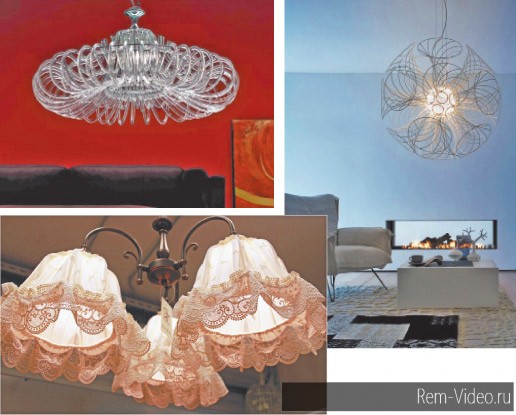 There are also calculations to determine the number of light bulbs needed for lighting certain area premises. Experts recommend paying attention to the following circumstance. When choosing a lighting device, you should take into account that manufacturers often write in the instructions for household lamps that they are intended for light bulbs with a power of no more than 60 watts. It is possible that manufacturers are playing it safe a little: a high-quality product is unlikely to burn out even from light bulbs with a power of 75 watts, which many have tried in their own experience. But Chinese products often have limitations in light bulb power of up to forty watts, and they probably won’t handle more. Experts believe that it is better not to take risks with any devices. The number of lamps in a chandelier should be calculated taking into account the specified restrictions and the area of the room. The calculations take into account the number of watts required to sufficiently illuminate one square meter area for various purposes. Experts give these figures. For example, for normal illumination in the living room, as well as in the kitchen, it is necessary to provide 25 watts per square meter. But for a bedroom, 20 watts is enough, while for a bathroom you need 30 watts. These figures are calculated for incandescent lamps. For energy saving lamps Other values are derived because they provide greater illumination with less energy consumption. For example, for the living room and kitchen - five watts, for the bedroom - four watts, and for the bathroom - six. However, the light bulb power required to provide normal illumination of one square meter of a room depends on the type of energy-saving lamp. And therefore for more precise calculation It is advisable to contact specialists. To determine the total power of incandescent lamps required to illuminate a living room, having an area of, say, 20 meters, you need to multiply 20 m by 25 (this is the standard illumination of one square meter). It turns out that for normal illumination of a twenty-meter room you need light bulbs, general power which is 500 watts. The given power can be provided, for example, by a five-arm chandelier with five 60-watt bulbs (total 300 watts), plus, say, a double sconce with two 60-watt bulbs, plus a floor lamp with one of the same bulbs. In total, side lighting is provided by three light bulbs with a total power of 180 watts. In total, it turns out to be 480 watts, that is, close to normal. However, you can screw two 70-watt bulbs into a sconce, and then the total power of the bulbs will be exactly 500 watts. Experts, however, recommend using energy-saving lamps, which significantly reduce energy costs. Various types of lamps
There are also calculations to determine the number of light bulbs needed for lighting certain area premises. Experts recommend paying attention to the following circumstance. When choosing a lighting device, you should take into account that manufacturers often write in the instructions for household lamps that they are intended for light bulbs with a power of no more than 60 watts. It is possible that manufacturers are playing it safe a little: a high-quality product is unlikely to burn out even from light bulbs with a power of 75 watts, which many have tried in their own experience. But Chinese products often have limitations in light bulb power of up to forty watts, and they probably won’t handle more. Experts believe that it is better not to take risks with any devices. The number of lamps in a chandelier should be calculated taking into account the specified restrictions and the area of the room. The calculations take into account the number of watts required to sufficiently illuminate one square meter area for various purposes. Experts give these figures. For example, for normal illumination in the living room, as well as in the kitchen, it is necessary to provide 25 watts per square meter. But for a bedroom, 20 watts is enough, while for a bathroom you need 30 watts. These figures are calculated for incandescent lamps. For energy saving lamps Other values are derived because they provide greater illumination with less energy consumption. For example, for the living room and kitchen - five watts, for the bedroom - four watts, and for the bathroom - six. However, the light bulb power required to provide normal illumination of one square meter of a room depends on the type of energy-saving lamp. And therefore for more precise calculation It is advisable to contact specialists. To determine the total power of incandescent lamps required to illuminate a living room, having an area of, say, 20 meters, you need to multiply 20 m by 25 (this is the standard illumination of one square meter). It turns out that for normal illumination of a twenty-meter room you need light bulbs, general power which is 500 watts. The given power can be provided, for example, by a five-arm chandelier with five 60-watt bulbs (total 300 watts), plus, say, a double sconce with two 60-watt bulbs, plus a floor lamp with one of the same bulbs. In total, side lighting is provided by three light bulbs with a total power of 180 watts. In total, it turns out to be 480 watts, that is, close to normal. However, you can screw two 70-watt bulbs into a sconce, and then the total power of the bulbs will be exactly 500 watts. Experts, however, recommend using energy-saving lamps, which significantly reduce energy costs. Various types of lamps
Chandeliers, like side lamps, can be divided into several groups, which differ both in functional characteristics and in external design. For example, a lamp with a closed shade or a chandelier with closed shades can seduce the buyer for various reasons, including interesting design. But sometimes the choice of lighting device is determined by safety regulations. For example, if a lamp is purchased for child care facility, fire-hazardous production or for some other organizations, then the lamp must have a closed shade. 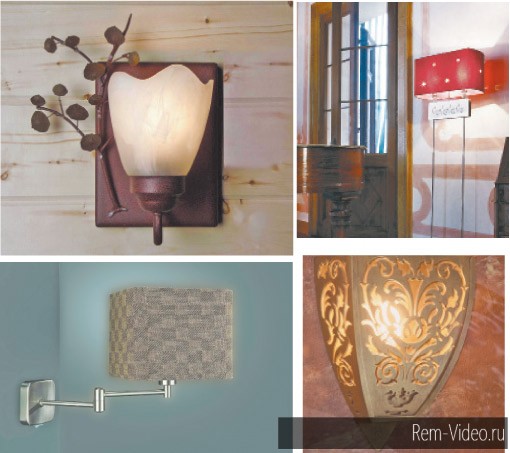 In this case, it is impossible for fragments of the light bulb to fall onto the floor if, suddenly, it cracks, or something else unexpected happens to it during the burnout process. It is precisely these blind, impact-resistant closed shades that are used to equip lamps in all fire-hazardous industries. Of course, such protection is appropriate in areas where children are present. True, in apartments it is not customary to “connect” via full program safety precautions, however, experts believe that in children's rooms it is advisable to choose lighting fixtures that “look” with the lampshade upward. They are also quite safe, since lamps very rarely fly apart with a bang in different directions. They usually "just burn out" or crack, leaving broken glass inside the lampshade, pointing upward. In addition, according to experts, it is advisable to hang ceiling lamps with closed shades in the bedroom, since diffused light that does not blind the eyes is more appropriate there. However, in some cases, upward-facing lampshades are not suitable. For example, for lighting desk, where, as a rule, directional illumination of the surface is required. Also, for rooms equipped with suspended ceilings, chandeliers with shades pointing downwards are needed. According to experts, the light of a lamp directed directly at suspended ceiling, may damage the material. For large room experts recommend choosing a collection of lighting fixtures of the same type, for example, consisting of a chandelier, sconce and floor lamp. The point is that in spacious room With high ceiling a chandelier cannot fully illuminate shadowed corners. Therefore, it is advisable to place auxiliary side lighting, for example, next to an armchair or sofa. It is worth considering that the market produces side and ceiling lighting fixtures in collectible sets - in a wide variety of colors and “styles”. Experts emphasize that for a chandelier that has a limitation in the power of light bulbs (for example, up to 60 watts), it is advisable to use energy-saving lamps, especially if the chandelier is supposed to illuminate a spacious room. For example, a 20-watt energy-saving light bulb illuminates a room about twice as brightly as a 60-watt light bulb. However, experts do not recommend making such a replacement in crystal chandeliers. In them, energy-saving lamps seem to be “lost”, since they do not have an incandescent filament, which is reflected in the pendants of a crystal chandelier, causing them to play with light. As we know, it is this property of crystal that attracts buyers. In addition, incandescent lamps, reflected in crystal pendants, enhance the brightness of the lighting fixture. Here comes the light energy saving light bulbs, as a rule, is distributed evenly, without bright “spots”, so the crystal does not play in the rays of energy-saving lamps. Chandeliers with fabric shades are also in certain demand. Lighting devices such as crystal chandeliers, experts consider it a classic. Usually classic chandeliers attached to the ceiling on chains or rods. Often the interior of a chandelier involves a floral theme, for example, flower-shaped lampshades. Chandeliers and ceiling lamps made in the Art Nouveau style have more strict outlines. Experts include in this group, for example, closed ceiling lamps, as well as wall lamps made in the form of a circle, semicircle, or a figure similar to a semicircle, but with broken contour lines. The Art Nouveau style is characterized by accessories, for example, a lampshade frame with a metallic sheen. Various lighting fixtures fit very well into the Art Nouveau style, although they were not created for stylistic design premises, and for the purpose uniform lighting paintings or mirrors.
In this case, it is impossible for fragments of the light bulb to fall onto the floor if, suddenly, it cracks, or something else unexpected happens to it during the burnout process. It is precisely these blind, impact-resistant closed shades that are used to equip lamps in all fire-hazardous industries. Of course, such protection is appropriate in areas where children are present. True, in apartments it is not customary to “connect” via full program safety precautions, however, experts believe that in children's rooms it is advisable to choose lighting fixtures that “look” with the lampshade upward. They are also quite safe, since lamps very rarely fly apart with a bang in different directions. They usually "just burn out" or crack, leaving broken glass inside the lampshade, pointing upward. In addition, according to experts, it is advisable to hang ceiling lamps with closed shades in the bedroom, since diffused light that does not blind the eyes is more appropriate there. However, in some cases, upward-facing lampshades are not suitable. For example, for lighting desk, where, as a rule, directional illumination of the surface is required. Also, for rooms equipped with suspended ceilings, chandeliers with shades pointing downwards are needed. According to experts, the light of a lamp directed directly at suspended ceiling, may damage the material. For large room experts recommend choosing a collection of lighting fixtures of the same type, for example, consisting of a chandelier, sconce and floor lamp. The point is that in spacious room With high ceiling a chandelier cannot fully illuminate shadowed corners. Therefore, it is advisable to place auxiliary side lighting, for example, next to an armchair or sofa. It is worth considering that the market produces side and ceiling lighting fixtures in collectible sets - in a wide variety of colors and “styles”. Experts emphasize that for a chandelier that has a limitation in the power of light bulbs (for example, up to 60 watts), it is advisable to use energy-saving lamps, especially if the chandelier is supposed to illuminate a spacious room. For example, a 20-watt energy-saving light bulb illuminates a room about twice as brightly as a 60-watt light bulb. However, experts do not recommend making such a replacement in crystal chandeliers. In them, energy-saving lamps seem to be “lost”, since they do not have an incandescent filament, which is reflected in the pendants of a crystal chandelier, causing them to play with light. As we know, it is this property of crystal that attracts buyers. In addition, incandescent lamps, reflected in crystal pendants, enhance the brightness of the lighting fixture. Here comes the light energy saving light bulbs, as a rule, is distributed evenly, without bright “spots”, so the crystal does not play in the rays of energy-saving lamps. Chandeliers with fabric shades are also in certain demand. Lighting devices such as crystal chandeliers, experts consider it a classic. Usually classic chandeliers attached to the ceiling on chains or rods. Often the interior of a chandelier involves a floral theme, for example, flower-shaped lampshades. Chandeliers and ceiling lamps made in the Art Nouveau style have more strict outlines. Experts include in this group, for example, closed ceiling lamps, as well as wall lamps made in the form of a circle, semicircle, or a figure similar to a semicircle, but with broken contour lines. The Art Nouveau style is characterized by accessories, for example, a lampshade frame with a metallic sheen. Various lighting fixtures fit very well into the Art Nouveau style, although they were not created for stylistic design premises, and for the purpose uniform lighting paintings or mirrors. 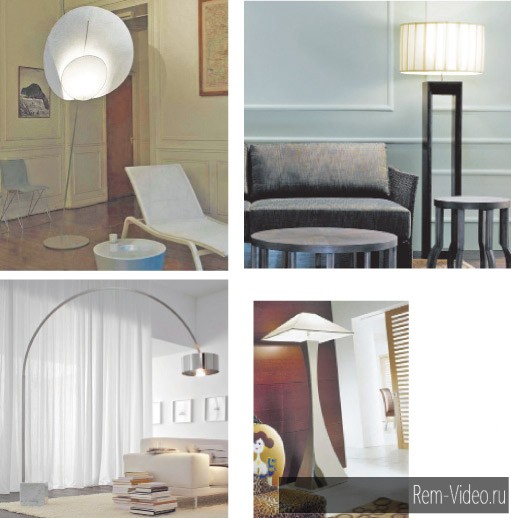 However, highlights often have a smooth metal case, which goes well, for example, with a metal frame wall lamp. True, the paintings that are illuminated by backlights may not at all reflect the modernist movement in painting. For correct lighting works of art, it doesn’t matter at all what style the canvas belongs to. It is important to choose the “right” light bulbs for lighting. Experts include, for example, halogen lamps or incandescent lamps. But it is better not to use fluorescent lamps for backlighting, since their “daylight” light distorts some colors on the canvases. Floor lamps equipped with very powerful halogen lamps have original stylistic solutions. According to experts, such a floor lamp can act as the main lighting device in the room, since it produces a powerful upward beam of light. Typically, designers recommend fitting powerful floor lamps into general interior premises. In particular, a white or very light ceiling is desirable, which will reflect the directional flow of light so that the illumination is evenly distributed throughout the room. According to experts, floor lamps equipped with powerful halogen lamps are now very popular. They fit especially well into the Art Nouveau style. Pairs perfectly with other lighting fixtures made in the same style or having related design elements. Experts note that mirrors with built-in lights have appeared on the market. A switch is cleverly hidden in the mirror frame. Thus, for a person looking at himself in a mirror, the direction of other lighting devices is not of fundamental importance. Lighting fixtures located in the bathroom require a special approach. Experts believe that the bathroom should be well lit. When selecting lighting fixtures and light bulbs, it is worth considering that, as a rule, waterproof matte lampshades are used in the bathroom. Frosted glass diffuses light and creates a lighting effect that is most favorable for the bathroom. And closed shades protect the light bulb from possible splashes. The first thing to suffer from water ingress is an incandescent lamp, since it gets very hot. Due to temperature changes, the lamp may even explode. And the owner of an unprotected light bulb may suffer from fragments.
However, highlights often have a smooth metal case, which goes well, for example, with a metal frame wall lamp. True, the paintings that are illuminated by backlights may not at all reflect the modernist movement in painting. For correct lighting works of art, it doesn’t matter at all what style the canvas belongs to. It is important to choose the “right” light bulbs for lighting. Experts include, for example, halogen lamps or incandescent lamps. But it is better not to use fluorescent lamps for backlighting, since their “daylight” light distorts some colors on the canvases. Floor lamps equipped with very powerful halogen lamps have original stylistic solutions. According to experts, such a floor lamp can act as the main lighting device in the room, since it produces a powerful upward beam of light. Typically, designers recommend fitting powerful floor lamps into general interior premises. In particular, a white or very light ceiling is desirable, which will reflect the directional flow of light so that the illumination is evenly distributed throughout the room. According to experts, floor lamps equipped with powerful halogen lamps are now very popular. They fit especially well into the Art Nouveau style. Pairs perfectly with other lighting fixtures made in the same style or having related design elements. Experts note that mirrors with built-in lights have appeared on the market. A switch is cleverly hidden in the mirror frame. Thus, for a person looking at himself in a mirror, the direction of other lighting devices is not of fundamental importance. Lighting fixtures located in the bathroom require a special approach. Experts believe that the bathroom should be well lit. When selecting lighting fixtures and light bulbs, it is worth considering that, as a rule, waterproof matte lampshades are used in the bathroom. Frosted glass diffuses light and creates a lighting effect that is most favorable for the bathroom. And closed shades protect the light bulb from possible splashes. The first thing to suffer from water ingress is an incandescent lamp, since it gets very hot. Due to temperature changes, the lamp may even explode. And the owner of an unprotected light bulb may suffer from fragments. 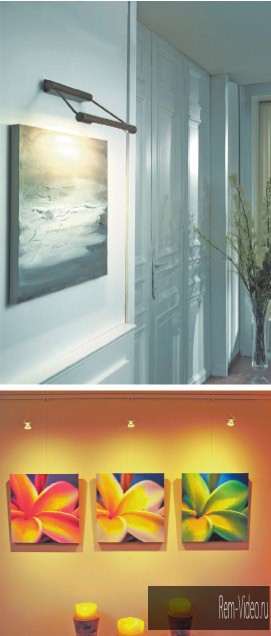 Solar lamp
Solar lamp
Among the most advanced modern lighting devices, experts include a garden lantern powered by solar batteries. This unit not only “supplies” light, but also generates electricity itself from a solar collector mounted in the upper part of the garden lamp. In addition, using a light sensor, the flashlight itself determines when it is time to turn on the light. The flashlight is equipped with a battery that stores energy during daylight hours. The light bulbs used in garden lamps consume very little energy, are very small in size, and at the same time perform their function well. The small size of the lamp gives ample opportunities designer for the stylistic design of a non-volatile street lamp. And low power consumption allows the battery to power the light bulb with accumulated solar energy for a long time. After all, not every day is sunny, so for our latitudes it is advisable to use the energy of the luminary carefully. Although clouds do not prevent the accumulation of solar energy, only low thunderclouds can interfere. According to experts, the lamp operates for eight hours from a well-charged battery, which is quite enough, especially for summer time. And here in early spring and in late autumn, with short daylight hours, the battery may not be fully charged. In this case, you can, for example, configure two non-volatile lamps to operate alternately. But at the same time, the light sensor should be supplemented with a device that counts the clock, which can turn on an additional garden lamp after a certain period of time - as soon as the battery of the first lighting device runs out. In winter in middle lane and in more northern areas, experts do not recommend using solar-powered lamps. But in southern regions, where the temperature practically never drops below zero, a non-volatile lamp can operate year-round. The fact is that batteries don't like severe frosts(which is well known to car owners). If the storage unit of a roof solar collector can be hidden in the depths warm roof, then the batteries of garden lamps are completely unprotected from frost. Therefore, experts recommend putting “solar” lamps in the utility room for the winter. Many non-volatile lighting fixtures are made of plastic. Often they imitate the shape of animals or even garden vegetation that “shines in the night.” However, there are lamps that have the traditional shape of a street lamp. They are original, but do not pretend to be special. However, there are also more demanding lighting fixtures made of metal, which can easily be classified as garden sculptures. Other lamps, made by the hands of experienced craftsmen, can rightfully be considered works of art. True, it is not so easy to remove a solid sculpture from the garden for the winter. Although a well-equipped garden usually has motorized equipment that can be used to solve this problem.
Tweet Galina Svinina
When developing a design concept for a room or a house as a whole, it is necessary to pay attention to many interconnected components that create overall harmony and integrity. Types of lighting in the interior, rules for selecting and installing lighting fixtures - at least important stage along with the definition color range, choice finishing materials and other design events.
Let's take a closer look this topic. After all, a lot depends on the filling with light. At correct use it can enliven a space, change the atmosphere of the room and hide some imperfections. Let's move away from old stereotypes, when it was considered traditional to have a chandelier on the ceiling, a sconce on the wall or a floor lamp next to the sofa. Currently, apartment lighting is turning into an art that can change the shape of objects, create accents and smooth out corners. All this became possible with the advent of various lighting devices and new trends in their use.
Types of modern lighting fixtures
Lighting devices can be divided into groups according to the type of mounting, the power of the lamps, the type of lamps used, as well as their number.
 A suspended light source is characterized by mounting lamps at a certain distance from the ceiling. Manufacturers of such lamps offer a huge variety of designs (glass, wood, ceramics, plastic, crystal). Pendant lights can be used in almost any room of the house.
A suspended light source is characterized by mounting lamps at a certain distance from the ceiling. Manufacturers of such lamps offer a huge variety of designs (glass, wood, ceramics, plastic, crystal). Pendant lights can be used in almost any room of the house.
Hanging options should be distinguished by the number of lamps. Single-lamp pendant lamps are the simplest design. It has one attachment to the ceiling in the form of a thin suspension, onto which a lampshade or light diffuser is attached. The light source is ordinary incandescent lamps and other types of lamps.
The only drawback of suspended structures is the inability to use them in rooms with low ceilings. Single-lamp lamps are often used to create original composition, mounted in groups of several pieces.
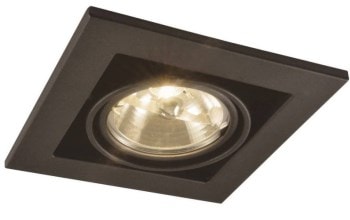 The peculiarity of recessed luminaires is that they are enclosed in a special housing for easy installation on planes.
The peculiarity of recessed luminaires is that they are enclosed in a special housing for easy installation on planes.
Built-in lamps can emit light in a narrow directional stream or diffuse it throughout the room. This type of installation is often used in home lighting.
Despite its small size, a spotlight can emit a powerful beam of light aimed at a specific area. Such lighting is often used where suspended, suspended or slatted ceilings are installed. Also, in homes they are installed in kitchen cabinets, to illuminate the desktop, in closets and dressing rooms, in rooms, to provide lighting for individual areas.
In recessed luminaires, the light source can be a halogen or reflector lamp. Designs in which you can change the direction of the flow of light rays are very convenient.
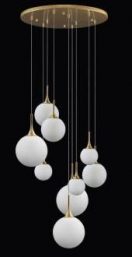 Wall samples are considered an additional source of lighting. They find application in any room and it is advisable to select them in the same style as the main source of lighting. The light source in such lamps can be a variety of lamps. Like all other types, wall lighting fixtures are made from various materials:
Wall samples are considered an additional source of lighting. They find application in any room and it is advisable to select them in the same style as the main source of lighting. The light source in such lamps can be a variety of lamps. Like all other types, wall lighting fixtures are made from various materials:
- Frosted and transparent glass.
- Plastic.
- Tree.
- Textiles.
- Crystal.
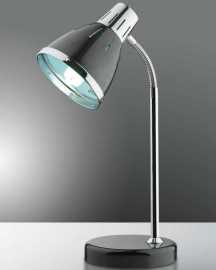 Such lamps are nothing more than well-known table lamps. These types of lighting fixtures are as functional as possible. At the same time, they can serve as an interesting accent in interior design. Table lamps can find a place in the house not only on the desktop, but also in the bedroom on nightstands near the bed.
Such lamps are nothing more than well-known table lamps. These types of lighting fixtures are as functional as possible. At the same time, they can serve as an interesting accent in interior design. Table lamps can find a place in the house not only on the desktop, but also in the bedroom on nightstands near the bed.
Today, such lamps are designed with maximum convenience in mind. They have flexible bases that can be adjusted to any height and angle. Also, as an addition, they can be securely attached to the tabletop. The light source can be different lamps, but it is preferable to use those that provide light that is comfortable for work.
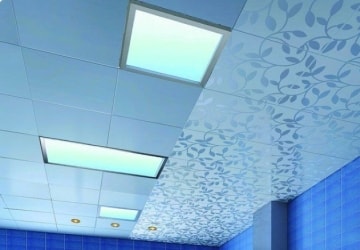 Built-in panel lights are mounted directly into a suspended ceiling (Armstrong, slatted). Their appearance resembles a box with a reflector and a light diffuser. The convenience of this lighting device is that the light sources can be placed in the optimal place for perception. In offices they are installed directly above the desktop.
Built-in panel lights are mounted directly into a suspended ceiling (Armstrong, slatted). Their appearance resembles a box with a reflector and a light diffuser. The convenience of this lighting device is that the light sources can be placed in the optimal place for perception. In offices they are installed directly above the desktop.
Built-in panel models are powered by fluorescent lamps that provide directional light. This feature makes it necessary to install several devices in one room to ensure uniform coverage over the entire area.
Despite functionality and utilitarianism, designers can sometimes offer non-standard solutions. But, more often such lamps are used in public places and shops.
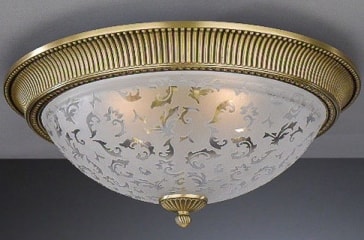 The light source in the ceiling lamp is partially or completely covered by a diffuser. The convenience of this design is its compactness and ease of installation. Lampshades are suitable for places where the ceiling is low and a regular chandelier would be in the way.
The light source in the ceiling lamp is partially or completely covered by a diffuser. The convenience of this design is its compactness and ease of installation. Lampshades are suitable for places where the ceiling is low and a regular chandelier would be in the way.
An important feature of many ceiling lamps– possibility of installation in rooms with high humidity(bath, sauna or swimming pool).
To implement original ideas designers are currently using various techniques, such as:
- Multi-level lighting.
- Bottom light (lights built into the floor).
- Systems of moving lamps.
- The use of numerous built-in spotlights in combination with a cascade of small pendant halogen lamps.
- Use of spotlights of various configurations.
- The use of lamps made for a specific architectural style.
Modern lighting is not complete without the use of LED sources light, the durability of which is much greater than that of incandescent lamps. They are more often used for illumination, both point and in the form LED strips(cords), which makes it possible to create amazing lighting effects.
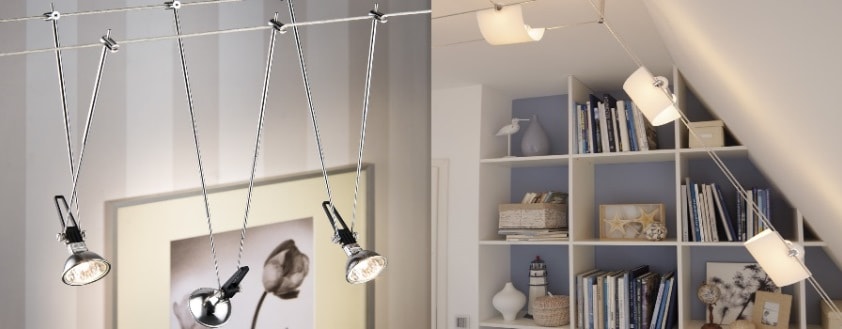
With the help of groups of spotlights, you can not only beautifully decorate the ceiling, but also create zoning of the room, illuminating certain places. Spot lighting, combined with other lighting fixtures, makes it possible to evenly cover the room and make the necessary accents.
Designers also have techniques in their arsenal that can be used to visually change the volume of a room. For example, if the walls and ceiling are decorated with reflective materials, then with the help of bright light you can visually expand the space. And by using lamps with reflectors pointing upward, you can visually raise low ceiling. If it is too tall, it is made lower by darkening its surface and placing lampshades on it with a light source pointing downwards.
Rules for various premises
General lighting in the living room, as a rule, should be unobtrusive and subdued, while local lighting should be brighter, illuminating various areas.
In the bedroom general light they make it soft and diffused, and the dressing table and bedside tables are equipped with stationary lighting fixtures.
The kitchen also has its own rules - individual lighting working area, for which spotlights are most often used, and lighting above dining table using lampshades or suspended structures.
For organization general lighting in the bathroom they use spotlights placed in suspended ceiling. Additionally, you can use sconces or LED backlights to illuminate the mirror.
For the hallway it is used as a spot ceiling lighting, and individual sconces, which in combination with mirrors give the effect visual expansion space.
Various types of lighting in the interior make it possible to beautifully decorate the entire space, creating comfort and reducing negative strain on the eyes.
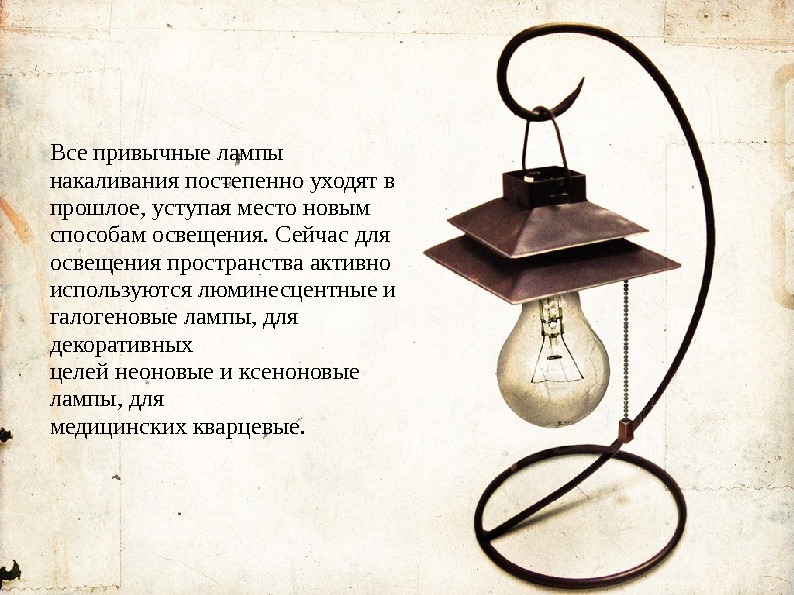 All the usual incandescent lamps are gradually becoming a thing of the past, giving way to new methods of lighting. Nowadays, fluorescent and halogen lamps are actively used to illuminate the space, neon and xenon lamps for decorative purposes, and quartz lamps for medical purposes.
All the usual incandescent lamps are gradually becoming a thing of the past, giving way to new methods of lighting. Nowadays, fluorescent and halogen lamps are actively used to illuminate the space, neon and xenon lamps for decorative purposes, and quartz lamps for medical purposes.
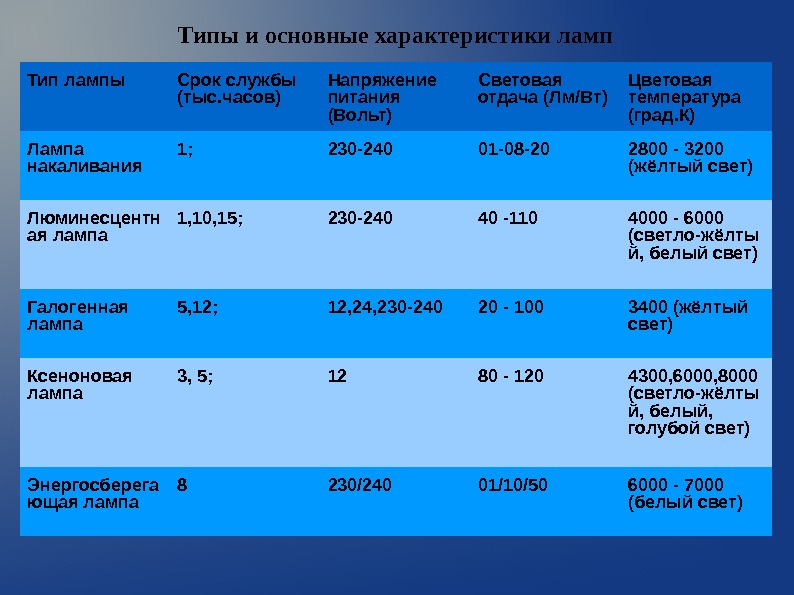 Lamp type Service life (thousand hours) Supply voltage (Volts) Luminous efficacy (Lm/W) Color temperature (degrees K) Incandescent lamp 1; 230 - 240 01 - 08 - 20 2800 - 3200 (yellow light) Fluorescent lamp 1, 10, 15; 230 -240 40 -110 4000 - 6000 (light yellow, white light) Halogen lamp 5, 12; 12, 24, 230 - 240 20 - 100 3400 (yellow light) Xenon lamp 3, 5 ; 12 80 - 120 4300, 6000, 8000 (light yellow, white, blue light) Energy saving lamp 8 230/240 01/10/50 6000 - 7000 (white light) Types and main characteristics of lamps
Lamp type Service life (thousand hours) Supply voltage (Volts) Luminous efficacy (Lm/W) Color temperature (degrees K) Incandescent lamp 1; 230 - 240 01 - 08 - 20 2800 - 3200 (yellow light) Fluorescent lamp 1, 10, 15; 230 -240 40 -110 4000 - 6000 (light yellow, white light) Halogen lamp 5, 12; 12, 24, 230 - 240 20 - 100 3400 (yellow light) Xenon lamp 3, 5 ; 12 80 - 120 4300, 6000, 8000 (light yellow, white, blue light) Energy saving lamp 8 230/240 01/10/50 6000 - 7000 (white light) Types and main characteristics of lamps
 Luminous output - ratio luminous flux To power consumption. It is measured in lumens per watt (lm/w). Color temperature is an indicator that determines the color tone of a light source. Measured in degrees on the Kelvin scale. For comparison: the color temperature of the Sun is 6000 degrees. K. Each lamp uses a specific type of socket, into which only a lamp that has a suitable base can be installed. When choosing a lamp for a luminaire, you should take into account not only the type of base, but also the lamp power allowed for the luminaire, the network voltage, the dimensions of the lamp suitable for a particular luminaire, and the connection diagram of the luminaire. Each type of base has its own designation, which allows you not to get lost in their fairly wide range.
Luminous output - ratio luminous flux To power consumption. It is measured in lumens per watt (lm/w). Color temperature is an indicator that determines the color tone of a light source. Measured in degrees on the Kelvin scale. For comparison: the color temperature of the Sun is 6000 degrees. K. Each lamp uses a specific type of socket, into which only a lamp that has a suitable base can be installed. When choosing a lamp for a luminaire, you should take into account not only the type of base, but also the lamp power allowed for the luminaire, the network voltage, the dimensions of the lamp suitable for a particular luminaire, and the connection diagram of the luminaire. Each type of base has its own designation, which allows you not to get lost in their fairly wide range.
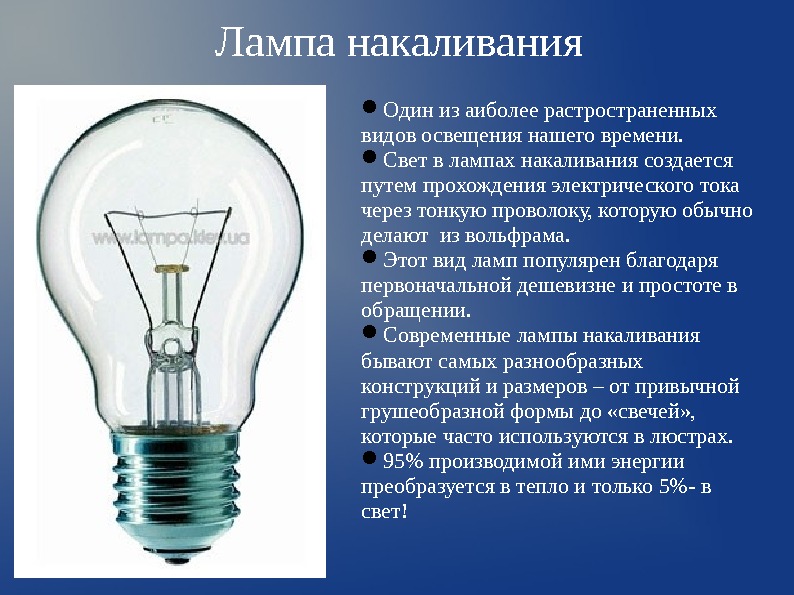 Incandescent lamp One of the most common types of lighting of our time. Light in incandescent lamps is created by passing an electric current through a thin wire, usually made of tungsten. This type of lamp is popular due to its initial low cost and ease of use. Modern lamps incandescent are the most various designs and sizes - from the usual pear-shaped shape to “candles”, which are often used in chandeliers. 95% of the energy they produce is converted into heat and only 5% into light!
Incandescent lamp One of the most common types of lighting of our time. Light in incandescent lamps is created by passing an electric current through a thin wire, usually made of tungsten. This type of lamp is popular due to its initial low cost and ease of use. Modern lamps incandescent are the most various designs and sizes - from the usual pear-shaped shape to “candles”, which are often used in chandeliers. 95% of the energy they produce is converted into heat and only 5% into light!

![]() Advantages: high color rendering index, Ra 100 well-established in mass production low cost small size no ballasts insensitivity to ionizing radiation purely active electrical resistance(unity power factor) quick return to operating mode low sensitivity to power failures and voltage surges absence of toxic components and, as a result, no need for collection and disposal infrastructure.
Advantages: high color rendering index, Ra 100 well-established in mass production low cost small size no ballasts insensitivity to ionizing radiation purely active electrical resistance(unity power factor) quick return to operating mode low sensitivity to power failures and voltage surges absence of toxic components and, as a result, no need for collection and disposal infrastructure.
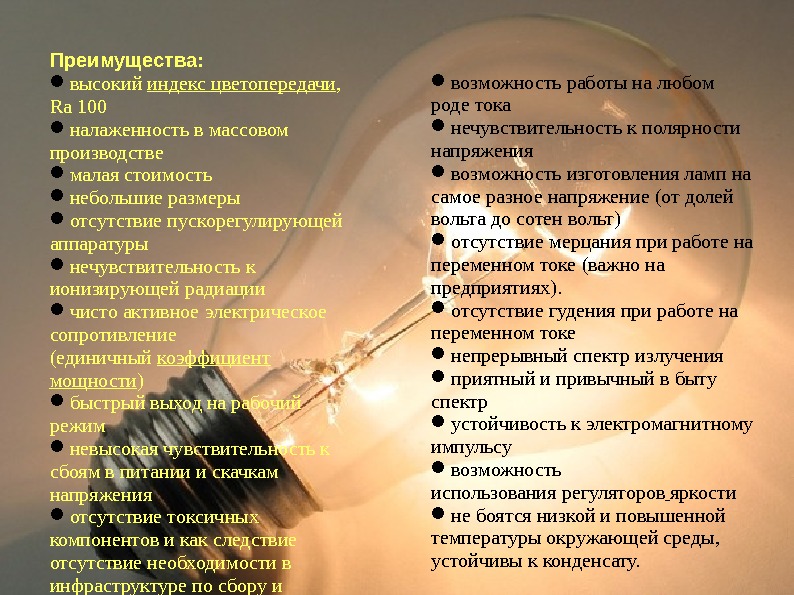 Advantages: high color rendering index, Ra 100 well-established in mass production low cost small size absence of ballasts insensitivity to ionizing radiation purely active electrical resistance (unit power factor) quick return to operating mode low sensitivity to power failures and voltage surges absence of toxic components and as a consequence, there is no need for collection and recycling infrastructure. the ability to operate on any type of current insensitive to voltage polarity the ability to manufacture lamps for a wide range of voltages (from fractions of a volt to hundreds of volts) no flicker when operating on alternating current(important in enterprises). absence of hum when operating on alternating current; continuous emission spectrum; pleasant and familiar spectrum in everyday life; resistance to electromagnetic pulse; possibility of using brightness controls; not afraid of low and high temperatures environment, resistant to condensation.
Advantages: high color rendering index, Ra 100 well-established in mass production low cost small size absence of ballasts insensitivity to ionizing radiation purely active electrical resistance (unit power factor) quick return to operating mode low sensitivity to power failures and voltage surges absence of toxic components and as a consequence, there is no need for collection and recycling infrastructure. the ability to operate on any type of current insensitive to voltage polarity the ability to manufacture lamps for a wide range of voltages (from fractions of a volt to hundreds of volts) no flicker when operating on alternating current(important in enterprises). absence of hum when operating on alternating current; continuous emission spectrum; pleasant and familiar spectrum in everyday life; resistance to electromagnetic pulse; possibility of using brightness controls; not afraid of low and high temperatures environment, resistant to condensation.
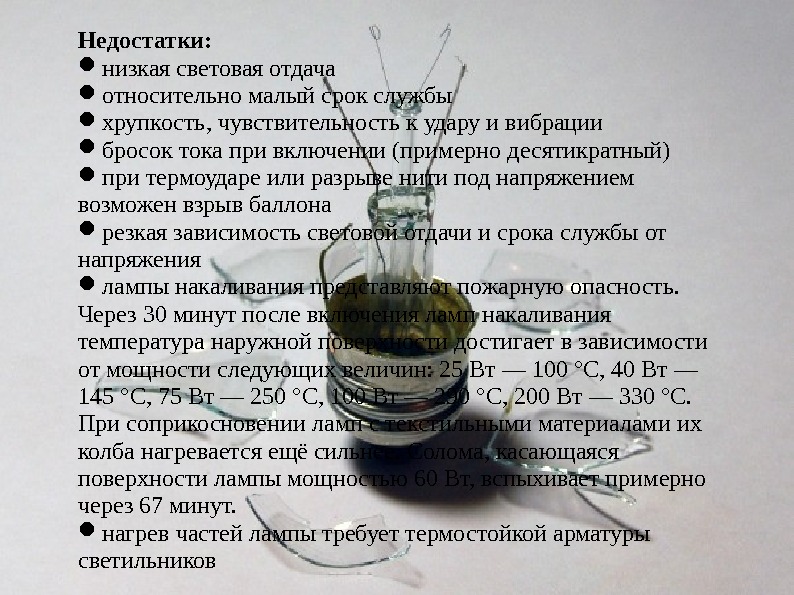 Disadvantages: low luminous efficiency relatively short service life fragility, sensitivity to shock and vibration current surge when turned on (approximately tenfold) in case of thermal shock or rupture of the filament under voltage the cylinder may explode sharp dependence of luminous efficiency and service life on the voltage of incandescent lamps fire danger. 30 minutes after turning on the incandescent lamps, the temperature of the outer surface reaches, depending on the power, the following values: 25 W - 100 °C, 40 W - 145 °C, 75 W - 250 °C, 100 W - 290 °C, 200 W - 330 °C. When the lamps come into contact with textile materials, their bulb heats up even more. Straw touching the surface of a 60 W lamp will ignite in approximately 67 minutes. heating of lamp parts requires heat-resistant fittings of lamps
Disadvantages: low luminous efficiency relatively short service life fragility, sensitivity to shock and vibration current surge when turned on (approximately tenfold) in case of thermal shock or rupture of the filament under voltage the cylinder may explode sharp dependence of luminous efficiency and service life on the voltage of incandescent lamps fire danger. 30 minutes after turning on the incandescent lamps, the temperature of the outer surface reaches, depending on the power, the following values: 25 W - 100 °C, 40 W - 145 °C, 75 W - 250 °C, 100 W - 290 °C, 200 W - 330 °C. When the lamps come into contact with textile materials, their bulb heats up even more. Straw touching the surface of a 60 W lamp will ignite in approximately 67 minutes. heating of lamp parts requires heat-resistant fittings of lamps
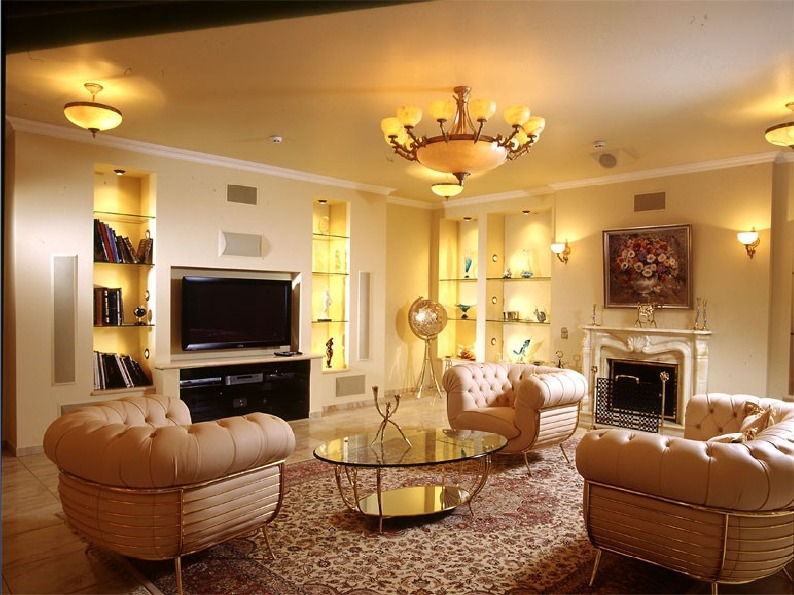
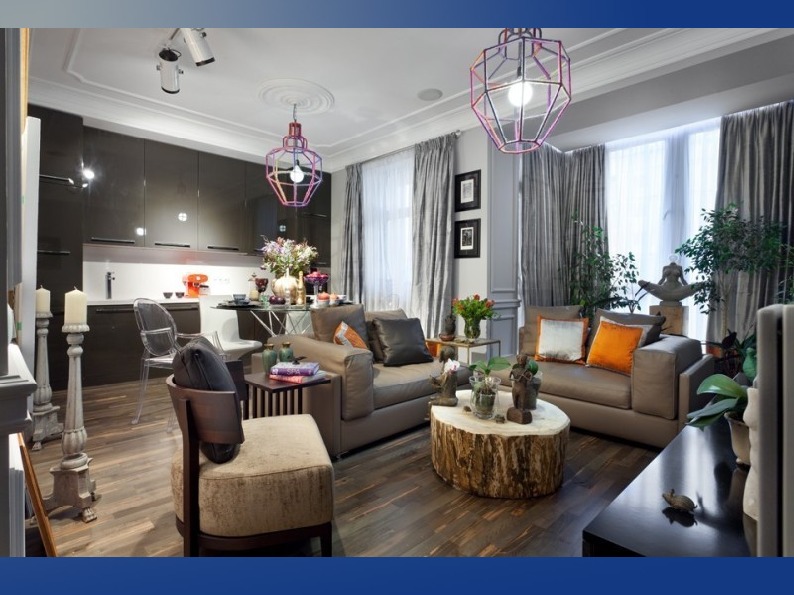
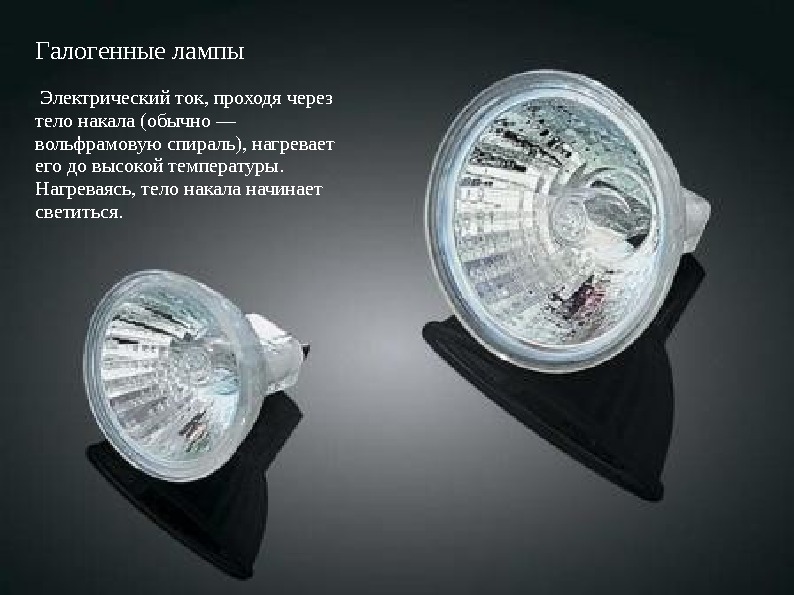 Halogen lamps An electric current passing through a filament body (usually a tungsten filament) heats it to a high temperature. When heated, the filament body begins to glow.
Halogen lamps An electric current passing through a filament body (usually a tungsten filament) heats it to a high temperature. When heated, the filament body begins to glow.
 In a halogen lamp, the iodine surrounding the filament (together with residual oxygen) enters chemical compound with evaporated tungsten atoms, preventing the latter from depositing on the flask. This process is reversible - with high temperatures near the filament body, the compound breaks down into its constituent substances. Tungsten atoms are released in this way either on the helix itself or near it. As a result, tungsten atoms return to the filament body, which makes it possible to increase the operating temperature of the filament (to produce brighter light), extend the life of the lamp, and also reduce the size compared to conventional incandescent lamps of the same power.
In a halogen lamp, the iodine surrounding the filament (together with residual oxygen) enters chemical compound with evaporated tungsten atoms, preventing the latter from depositing on the flask. This process is reversible - with high temperatures near the filament body, the compound breaks down into its constituent substances. Tungsten atoms are released in this way either on the helix itself or near it. As a result, tungsten atoms return to the filament body, which makes it possible to increase the operating temperature of the filament (to produce brighter light), extend the life of the lamp, and also reduce the size compared to conventional incandescent lamps of the same power.
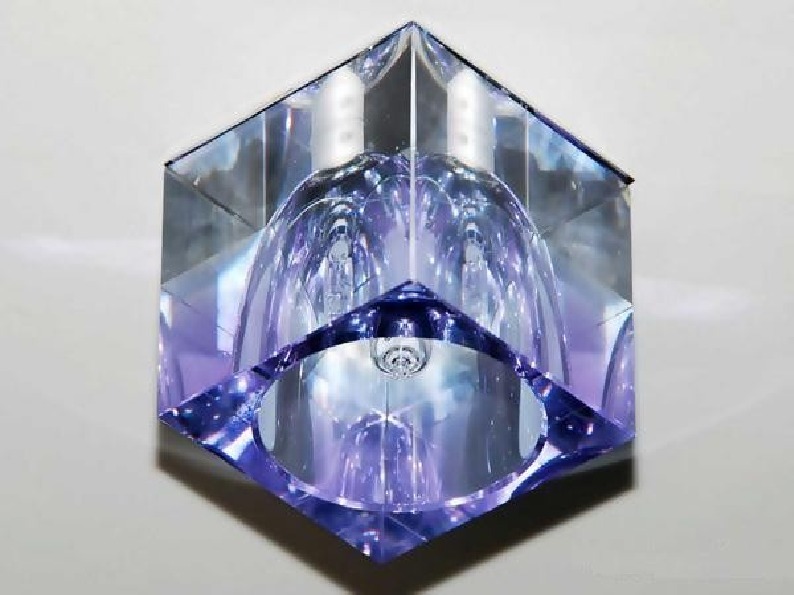
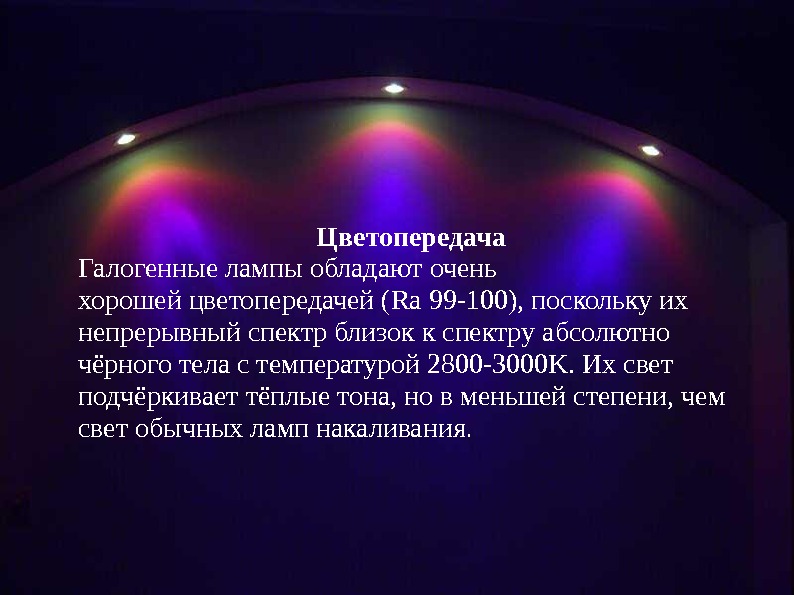 Color rendering Halogen lamps have very good color rendering (Ra 99 -100), since their continuous spectrum is close to that of a black body with a temperature of 2800 -3000 K. Their light emphasizes warm colors, but to a lesser extent than the light of conventional incandescent lamps.
Color rendering Halogen lamps have very good color rendering (Ra 99 -100), since their continuous spectrum is close to that of a black body with a temperature of 2800 -3000 K. Their light emphasizes warm colors, but to a lesser extent than the light of conventional incandescent lamps.
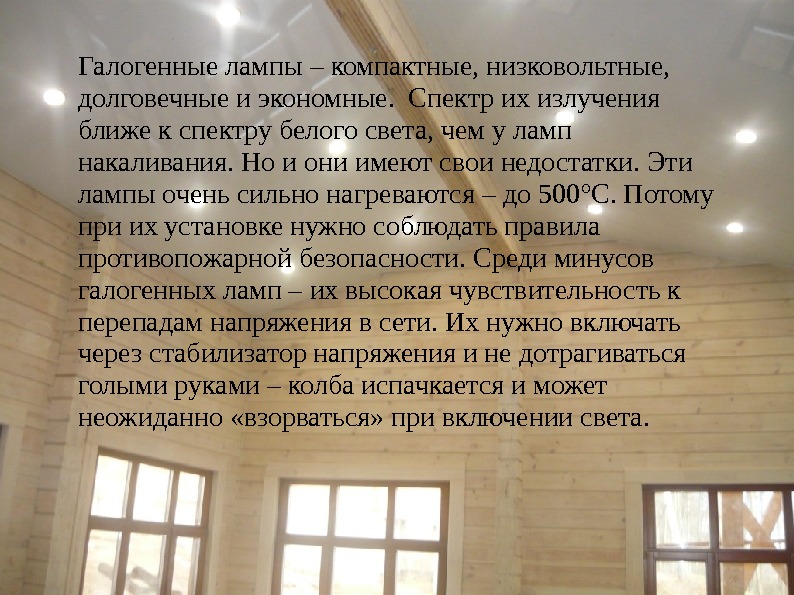 Halogen lamps are compact, low-voltage, durable and economical. Their emission spectrum is closer to the spectrum of white light than that of incandescent lamps. But they also have their drawbacks. These lamps get very hot – up to 500°C. Therefore, when installing them, you must comply with fire safety rules. Among the disadvantages of halogen lamps is their high sensitivity to voltage changes in the network. They need to be turned on through a voltage stabilizer and not touched with bare hands - the bulb will get dirty and may unexpectedly “explode” when the light is turned on.
Halogen lamps are compact, low-voltage, durable and economical. Their emission spectrum is closer to the spectrum of white light than that of incandescent lamps. But they also have their drawbacks. These lamps get very hot – up to 500°C. Therefore, when installing them, you must comply with fire safety rules. Among the disadvantages of halogen lamps is their high sensitivity to voltage changes in the network. They need to be turned on through a voltage stabilizer and not touched with bare hands - the bulb will get dirty and may unexpectedly “explode” when the light is turned on.
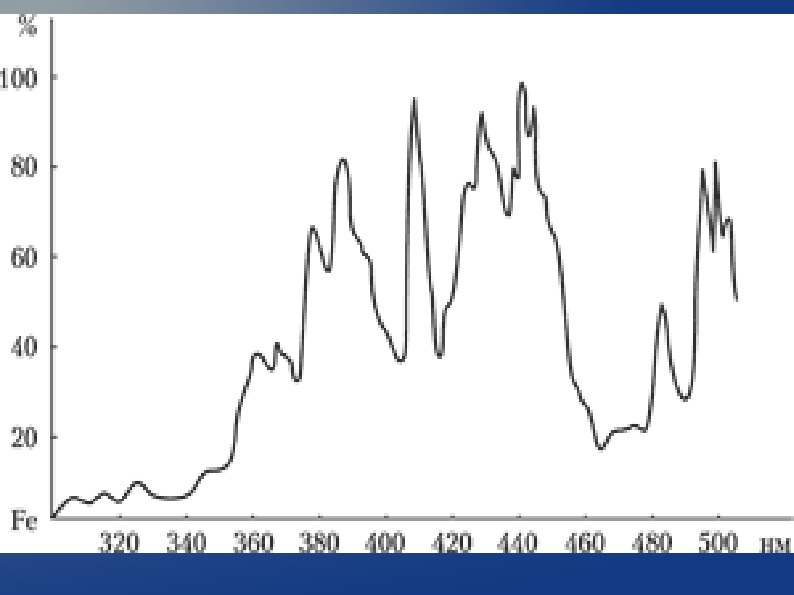
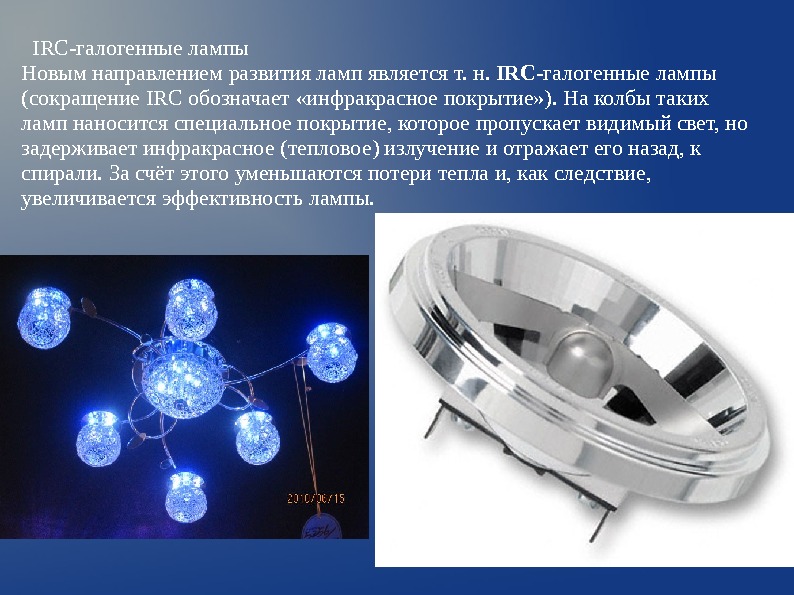 IRC-halogen lamps A new direction in the development of lamps is the so-called. IRC halogen lamps (IRC stands for “infrared coating”). A special coating is applied to the bulbs of such lamps, which allows visible light to pass through, but retains infrared (thermal) radiation and reflects it back to the spiral. Due to this, heat loss is reduced and, as a result, the efficiency of the lamp increases.
IRC-halogen lamps A new direction in the development of lamps is the so-called. IRC halogen lamps (IRC stands for “infrared coating”). A special coating is applied to the bulbs of such lamps, which allows visible light to pass through, but retains infrared (thermal) radiation and reflects it back to the spiral. Due to this, heat loss is reduced and, as a result, the efficiency of the lamp increases.
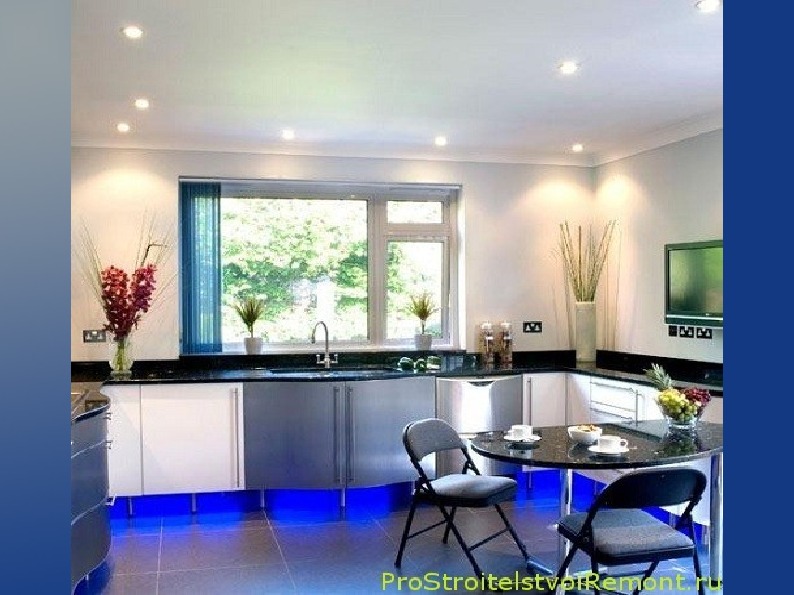
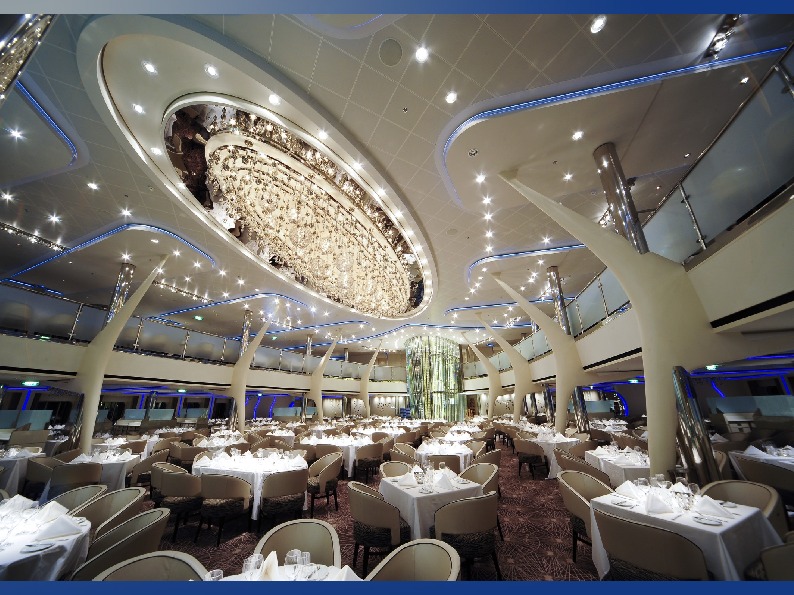
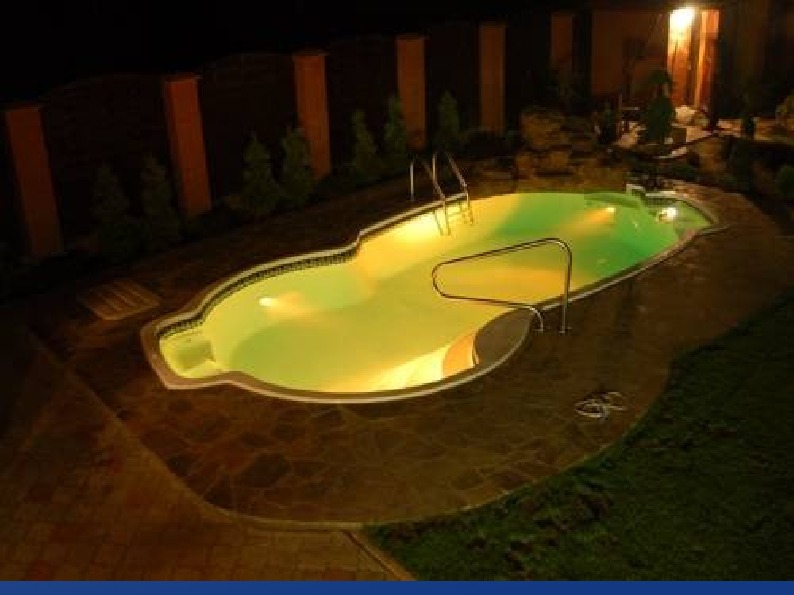
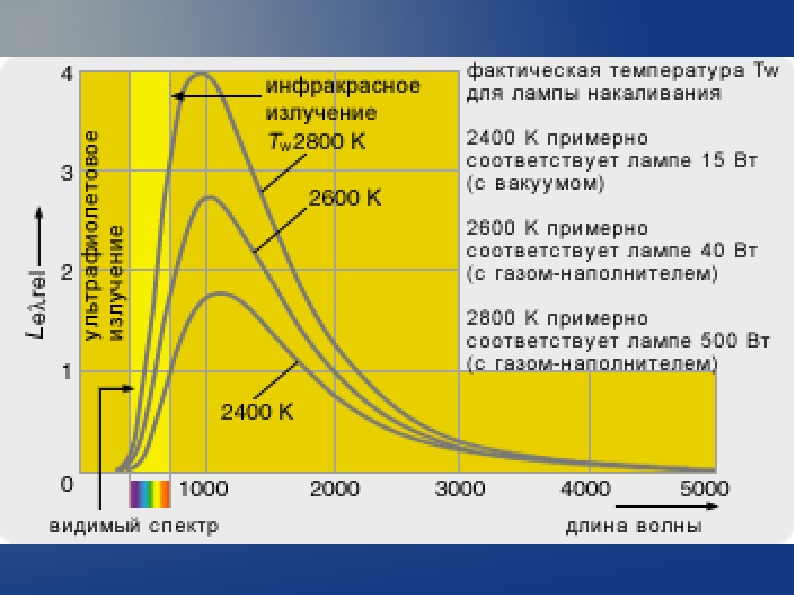
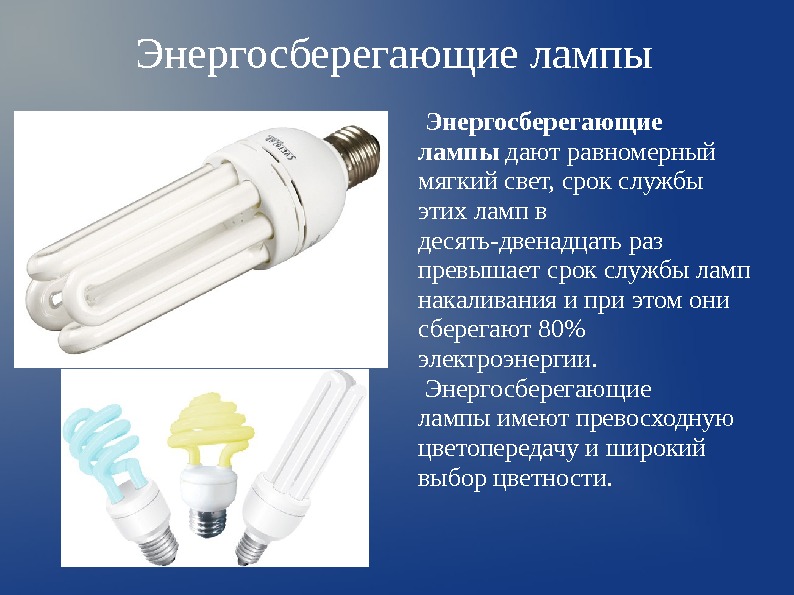 Energy-saving lamps provide uniform, soft light; the service life of these lamps is ten to twelve times longer than the service life of incandescent lamps and at the same time they save 80% of electricity. Energy-saving lamps have excellent color rendering and a wide range of colors.
Energy-saving lamps provide uniform, soft light; the service life of these lamps is ten to twelve times longer than the service life of incandescent lamps and at the same time they save 80% of electricity. Energy-saving lamps have excellent color rendering and a wide range of colors.
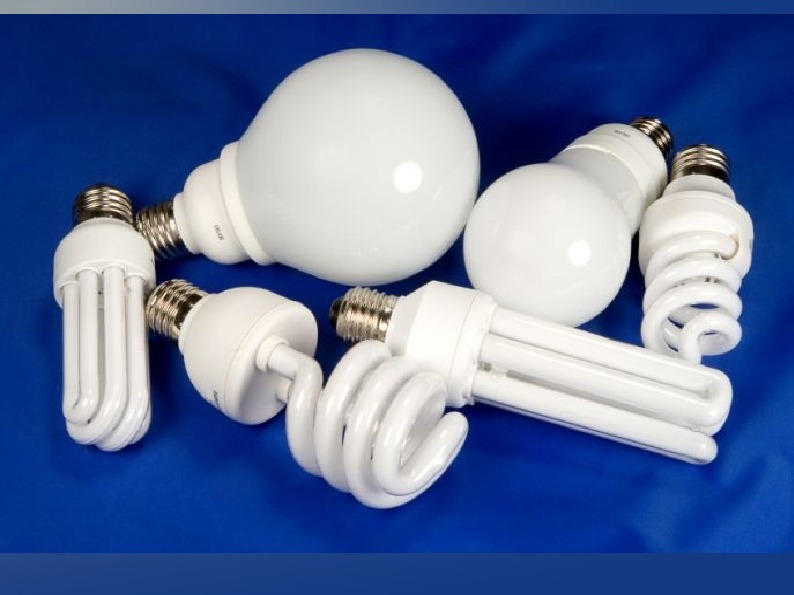
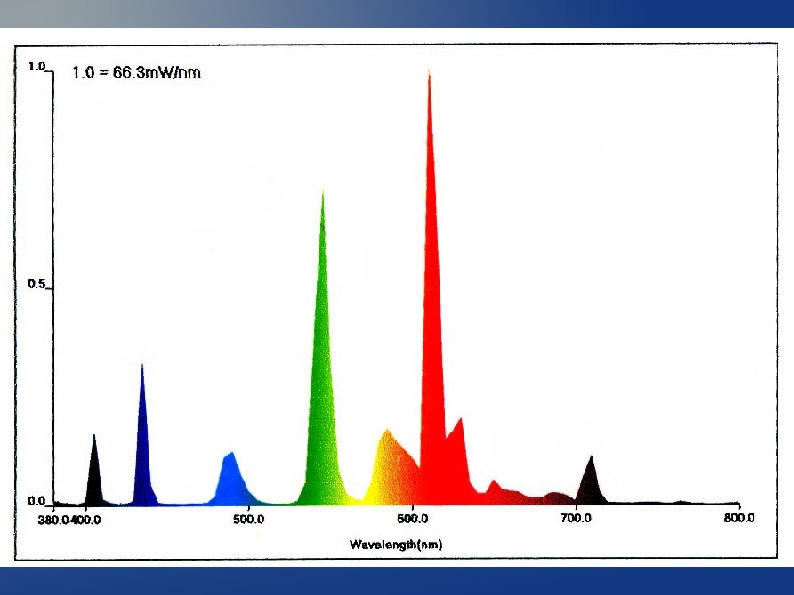
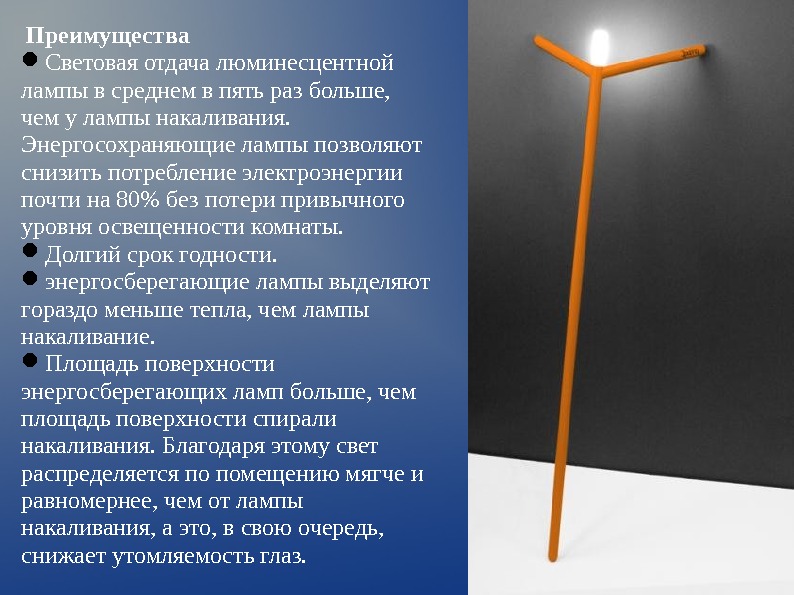 Advantages The luminous output of a fluorescent lamp is on average five times greater than that of an incandescent lamp. Energy-saving lamps can reduce energy consumption by almost 80% without losing the usual level of illumination in the room. Long shelf life. Energy-saving lamps emit much less heat than incandescent lamps. The surface area of energy-saving lamps is larger than the surface area of an incandescent filament. Thanks to this, the light is distributed throughout the room softer and more evenly than from an incandescent lamp, and this, in turn, reduces eye fatigue.
Advantages The luminous output of a fluorescent lamp is on average five times greater than that of an incandescent lamp. Energy-saving lamps can reduce energy consumption by almost 80% without losing the usual level of illumination in the room. Long shelf life. Energy-saving lamps emit much less heat than incandescent lamps. The surface area of energy-saving lamps is larger than the surface area of an incandescent filament. Thanks to this, the light is distributed throughout the room softer and more evenly than from an incandescent lamp, and this, in turn, reduces eye fatigue.
 Disadvantages of energy-saving lamps Probably the only disadvantage of energy-saving lamps is their fairly high cost. The energy-saving lamp is filled with mercury vapor, so you should avoid breaking it indoors. Disposal of environmentally harmful energy-saving lamps is also a problem, so throwing them away is actually prohibited.
Disadvantages of energy-saving lamps Probably the only disadvantage of energy-saving lamps is their fairly high cost. The energy-saving lamp is filled with mercury vapor, so you should avoid breaking it indoors. Disposal of environmentally harmful energy-saving lamps is also a problem, so throwing them away is actually prohibited.
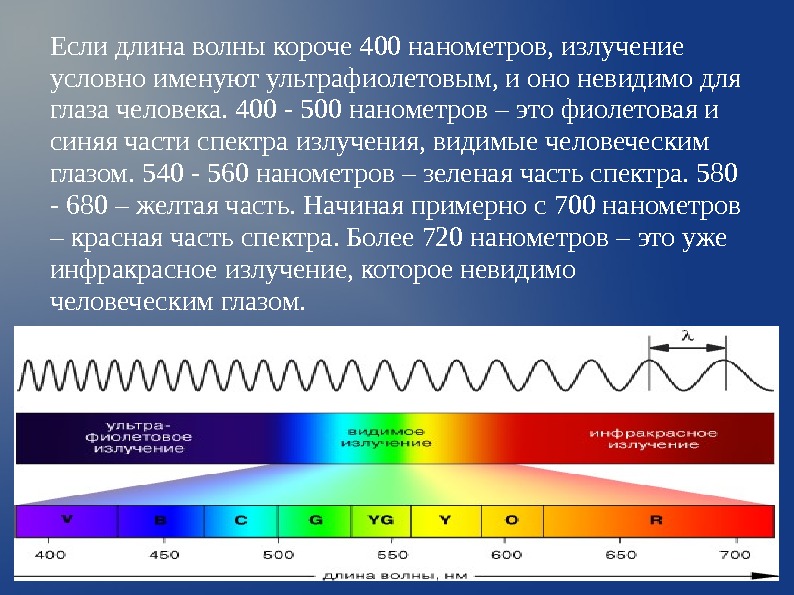 If the wavelength is shorter than 400 nanometers, the radiation is conventionally called ultraviolet, and it is invisible to the human eye. 400 - 500 nanometers are the violet and blue parts of the radiation spectrum, visible to the human eye. 540 - 560 nanometers - the green part of the spectrum. 580 – 680 – yellow part. Starting from about 700 nanometers is the red part of the spectrum. More than 720 nanometers is already infrared radiation, which is invisible to the human eye.
If the wavelength is shorter than 400 nanometers, the radiation is conventionally called ultraviolet, and it is invisible to the human eye. 400 - 500 nanometers are the violet and blue parts of the radiation spectrum, visible to the human eye. 540 - 560 nanometers - the green part of the spectrum. 580 – 680 – yellow part. Starting from about 700 nanometers is the red part of the spectrum. More than 720 nanometers is already infrared radiation, which is invisible to the human eye.
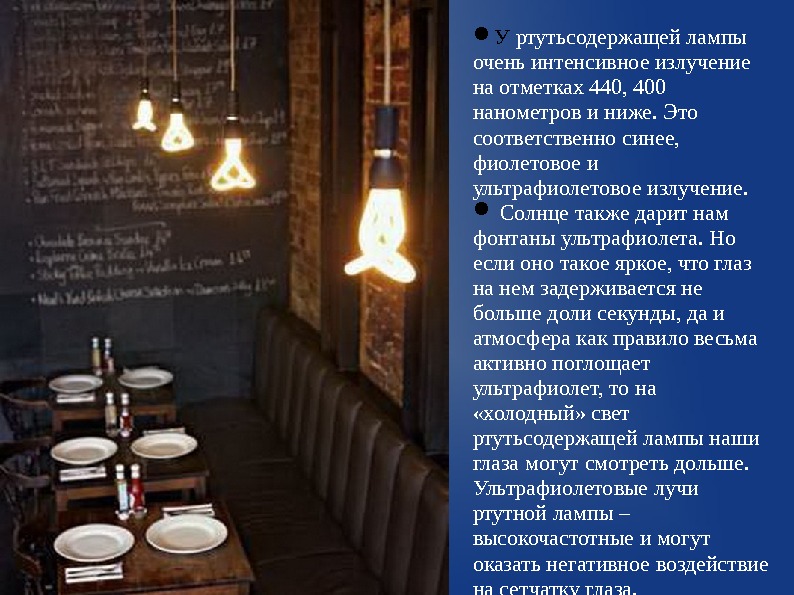 A mercury-containing lamp has very intense radiation at 440, 400 nanometers and below. These are blue, violet and ultraviolet radiation, respectively. The sun also gives us fountains of ultraviolet radiation. But if it is so bright that the eye lingers on it for no more than a split second, and the atmosphere, as a rule, very actively absorbs ultraviolet radiation, then our eyes can look at the “cold” light of a mercury-containing lamp longer. Ultra-violet rays mercury lamp– high-frequency and can have negative impact to the retina of the eye.
A mercury-containing lamp has very intense radiation at 440, 400 nanometers and below. These are blue, violet and ultraviolet radiation, respectively. The sun also gives us fountains of ultraviolet radiation. But if it is so bright that the eye lingers on it for no more than a split second, and the atmosphere, as a rule, very actively absorbs ultraviolet radiation, then our eyes can look at the “cold” light of a mercury-containing lamp longer. Ultra-violet rays mercury lamp– high-frequency and can have negative impact to the retina of the eye.
![]()
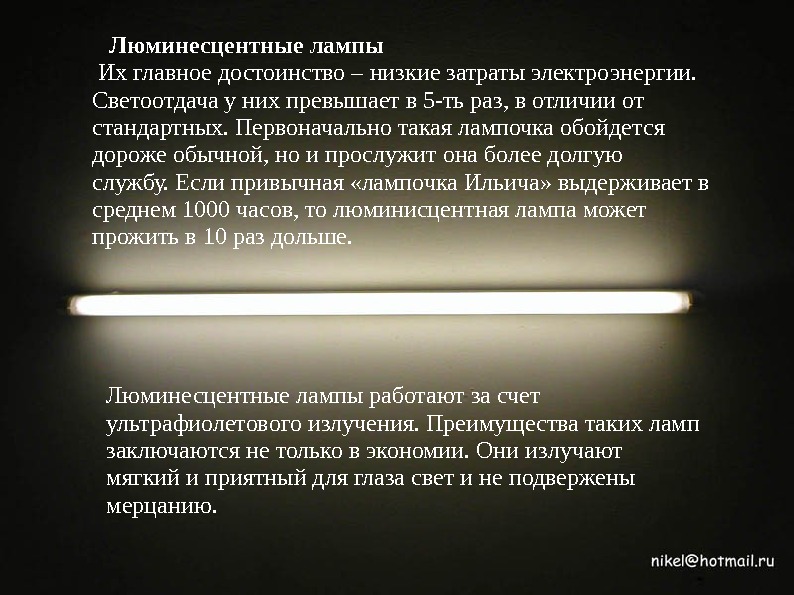 Fluorescent lamps Their main advantage is low energy costs. Their light output is 5 times higher than standard ones. Initially, such a light bulb will cost more than a regular one, but it will also last longer. If the usual “Ilyich light bulb” lasts an average of 1000 hours, then a fluorescent lamp can last 10 times longer. Fluorescent lamps work by ultraviolet radiation. The advantages of such lamps are not only savings. They emit light that is soft and pleasant to the eye and are not subject to flicker.
Fluorescent lamps Their main advantage is low energy costs. Their light output is 5 times higher than standard ones. Initially, such a light bulb will cost more than a regular one, but it will also last longer. If the usual “Ilyich light bulb” lasts an average of 1000 hours, then a fluorescent lamp can last 10 times longer. Fluorescent lamps work by ultraviolet radiation. The advantages of such lamps are not only savings. They emit light that is soft and pleasant to the eye and are not subject to flicker.
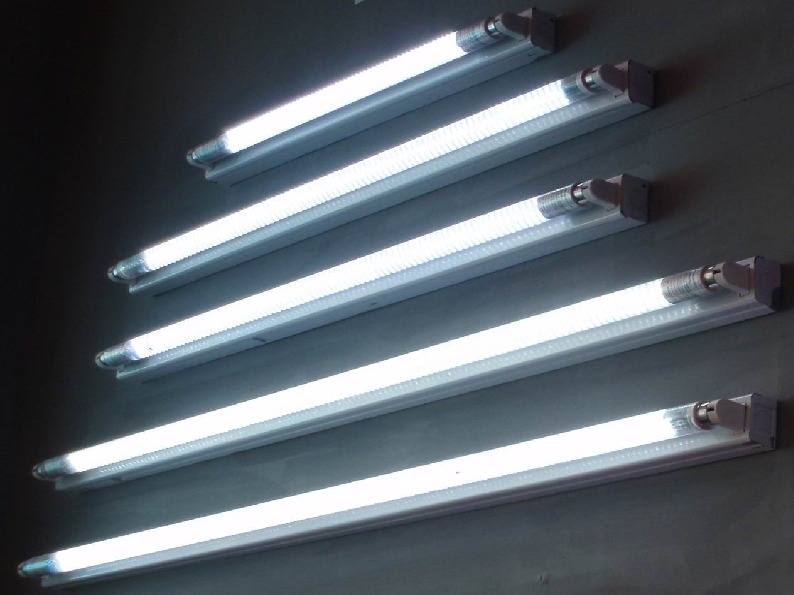
 Advantages: significantly higher light output (a 20 W fluorescent lamp provides the same illumination as a 100 W incandescent lamp) and higher efficiency; lamp emission spectrum close to natural; variety of shades of light; diffused light; long service life (2000 -20,000 hours, as opposed to 1000 for incandescent lamps), provided that sufficient quality of power supply, ballast and compliance with restrictions on the number of starts and stops are observed. Disadvantages: chemical hazard; the presence of an additional device for starting the lamp - a ballast (a bulky, noisy choke with an unreliable starter or electronic ballast); flickering of the lamp at the frequency of the mains supply (evened out by the use of electronic ballasts); a failed starter causes a false start of the lamp (several flashes are visually detected before stable ignition), reducing the service life of the filaments; very low power factor of lamps - such lamps are an unsuccessful load for the electrical network (evented by the use of electronic ballasts);
Advantages: significantly higher light output (a 20 W fluorescent lamp provides the same illumination as a 100 W incandescent lamp) and higher efficiency; lamp emission spectrum close to natural; variety of shades of light; diffused light; long service life (2000 -20,000 hours, as opposed to 1000 for incandescent lamps), provided that sufficient quality of power supply, ballast and compliance with restrictions on the number of starts and stops are observed. Disadvantages: chemical hazard; the presence of an additional device for starting the lamp - a ballast (a bulky, noisy choke with an unreliable starter or electronic ballast); flickering of the lamp at the frequency of the mains supply (evened out by the use of electronic ballasts); a failed starter causes a false start of the lamp (several flashes are visually detected before stable ignition), reducing the service life of the filaments; very low power factor of lamps - such lamps are an unsuccessful load for the electrical network (evented by the use of electronic ballasts);
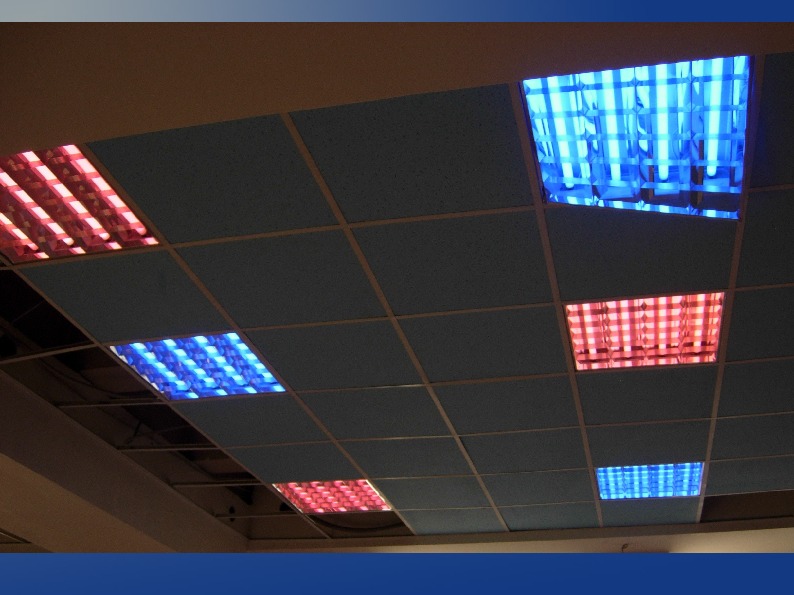
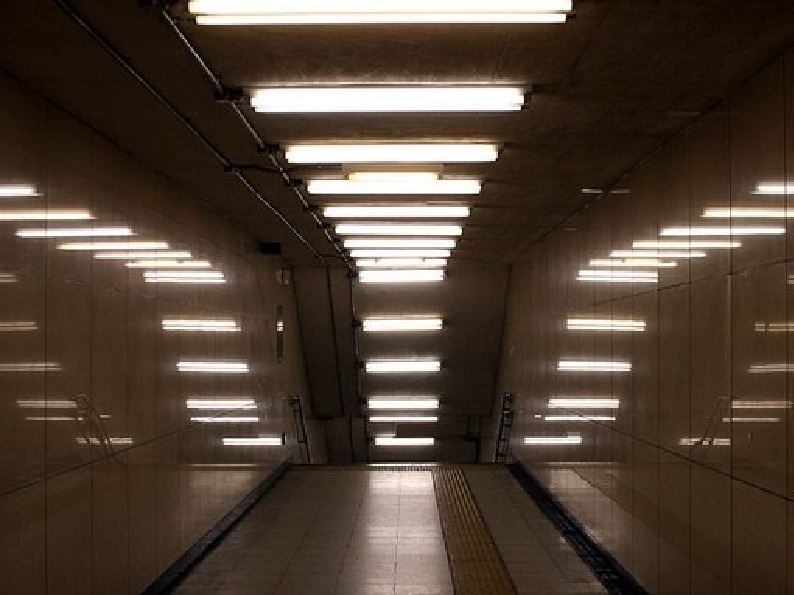
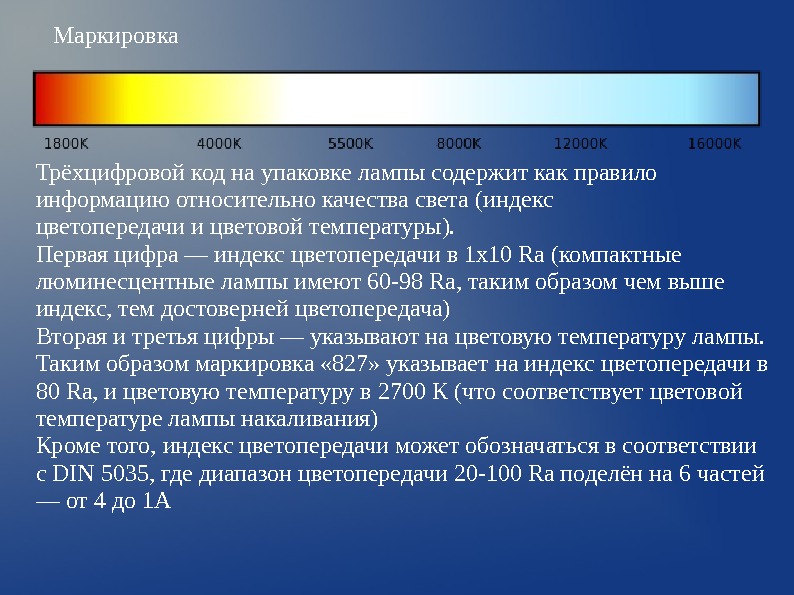 Marking The three-digit code on the lamp packaging usually contains information regarding the quality of light (color rendering index and color temperature). The first number is a color rendering index of 1 x10 Ra (compact fluorescent lamps have 60 -98 Ra, so the higher the index, the more reliable the color rendering) The second and third numbers indicate the color temperature of the lamp. Thus, the marking “827” indicates a color rendering index of 80 Ra, and a color temperature of 2700 K (which corresponds to the color temperature of an incandescent lamp). In addition, the color rendering index can be indicated in accordance with DIN 5035, where the color rendering range of 20 -100 Ra is divided by 6 parts - from 4 to 1 A
Marking The three-digit code on the lamp packaging usually contains information regarding the quality of light (color rendering index and color temperature). The first number is a color rendering index of 1 x10 Ra (compact fluorescent lamps have 60 -98 Ra, so the higher the index, the more reliable the color rendering) The second and third numbers indicate the color temperature of the lamp. Thus, the marking “827” indicates a color rendering index of 80 Ra, and a color temperature of 2700 K (which corresponds to the color temperature of an incandescent lamp). In addition, the color rendering index can be indicated in accordance with DIN 5035, where the color rendering range of 20 -100 Ra is divided by 6 parts - from 4 to 1 A
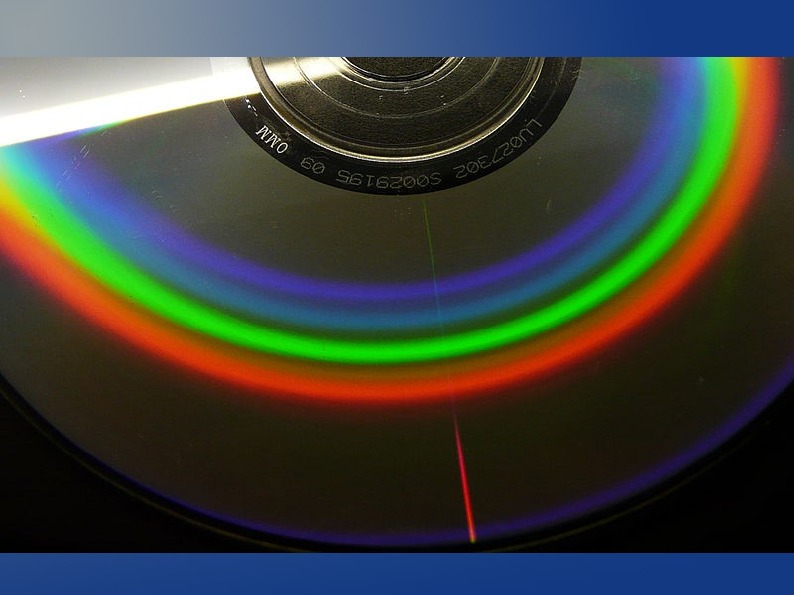
 Peculiarities of perception Human color perception varies greatly depending on brightness. At low brightness, we see blue better and red worse. Therefore the color temperature daylight(5000 -6500 K) will appear excessively blue in low light conditions. The average illumination in residential areas is 75 lux, while in offices and other work areas it is 400 lux. At low brightness (50 -75 lux), light with a temperature of 3000 K looks most natural. At a brightness of 400 lux, such light already appears yellow, and light with a temperature of 4000 -6000 K seems most natural.
Peculiarities of perception Human color perception varies greatly depending on brightness. At low brightness, we see blue better and red worse. Therefore the color temperature daylight(5000 -6500 K) will appear excessively blue in low light conditions. The average illumination in residential areas is 75 lux, while in offices and other work areas it is 400 lux. At low brightness (50 -75 lux), light with a temperature of 3000 K looks most natural. At a brightness of 400 lux, such light already appears yellow, and light with a temperature of 4000 -6000 K seems most natural.
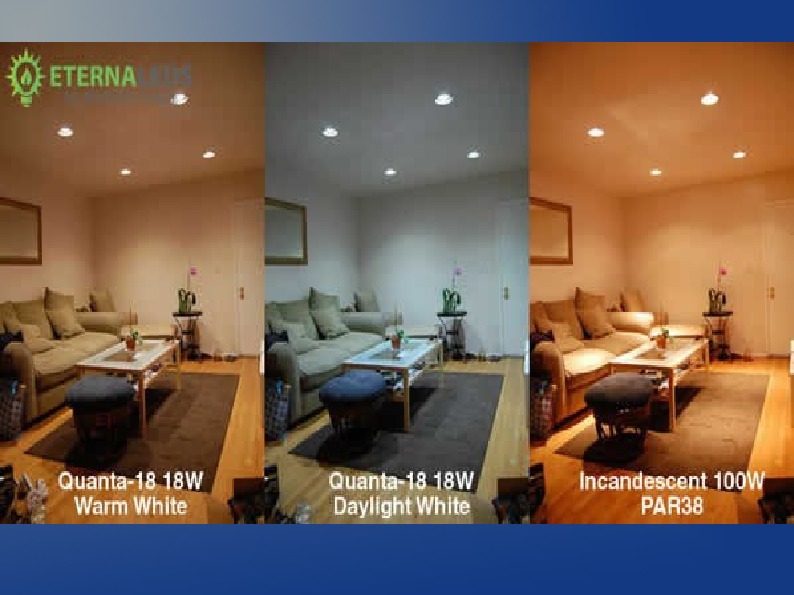
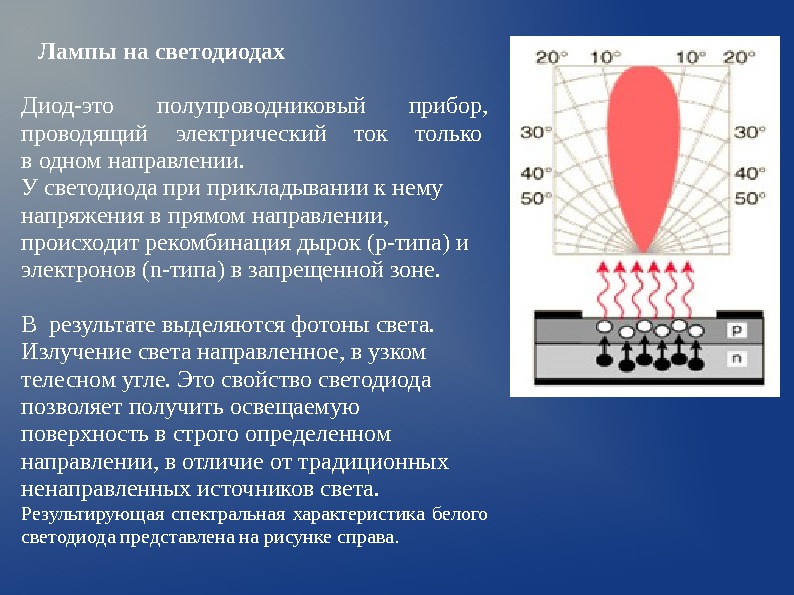 LED lamps A diode is a semiconductor device that conducts electricity only in one direction. In an LED, when a voltage is applied to it in the forward direction, recombination of holes (p-type) and electrons (n-type) occurs in the bandgap. As a result, photons of light are released. Light emission is directed, in a narrow solid angle. This property of the LED allows you to obtain an illuminated surface in a strictly defined direction, in contrast to traditional non-directional light sources. The resulting spectral response of the white LED is shown in the figure to the right.
LED lamps A diode is a semiconductor device that conducts electricity only in one direction. In an LED, when a voltage is applied to it in the forward direction, recombination of holes (p-type) and electrons (n-type) occurs in the bandgap. As a result, photons of light are released. Light emission is directed, in a narrow solid angle. This property of the LED allows you to obtain an illuminated surface in a strictly defined direction, in contrast to traditional non-directional light sources. The resulting spectral response of the white LED is shown in the figure to the right.
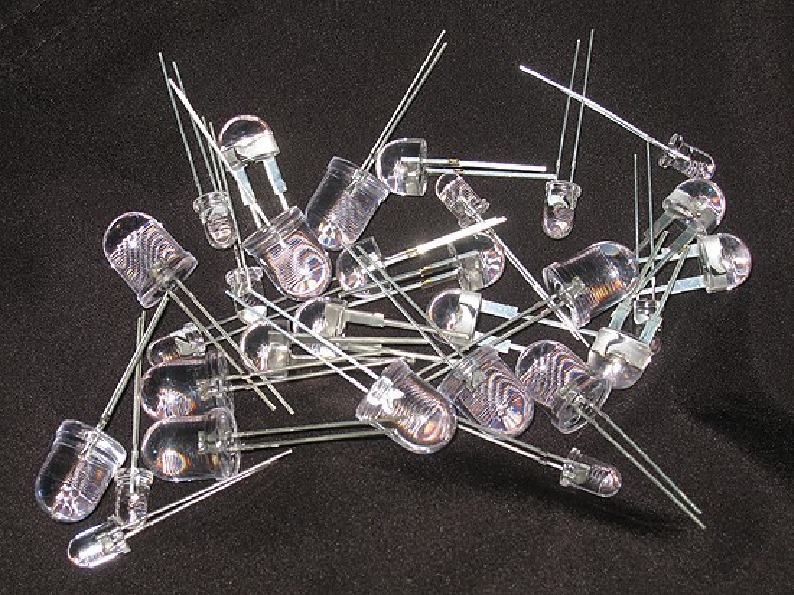
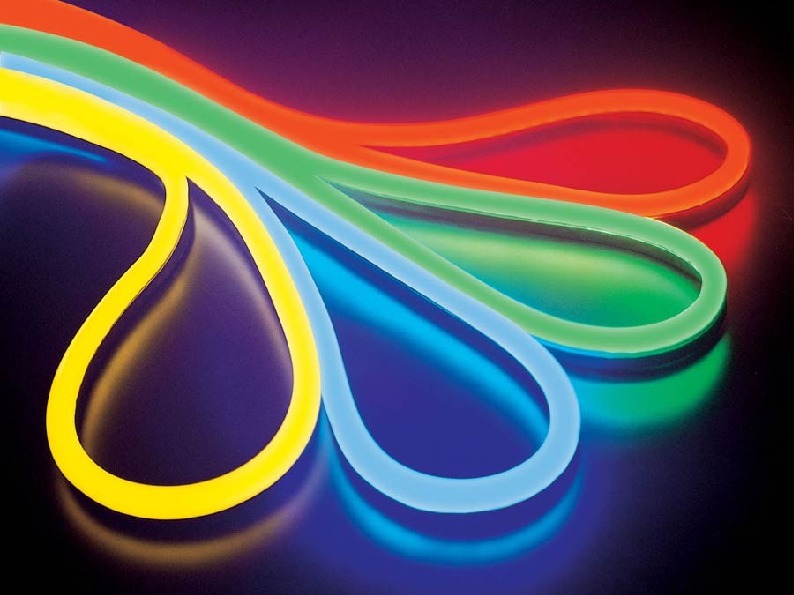
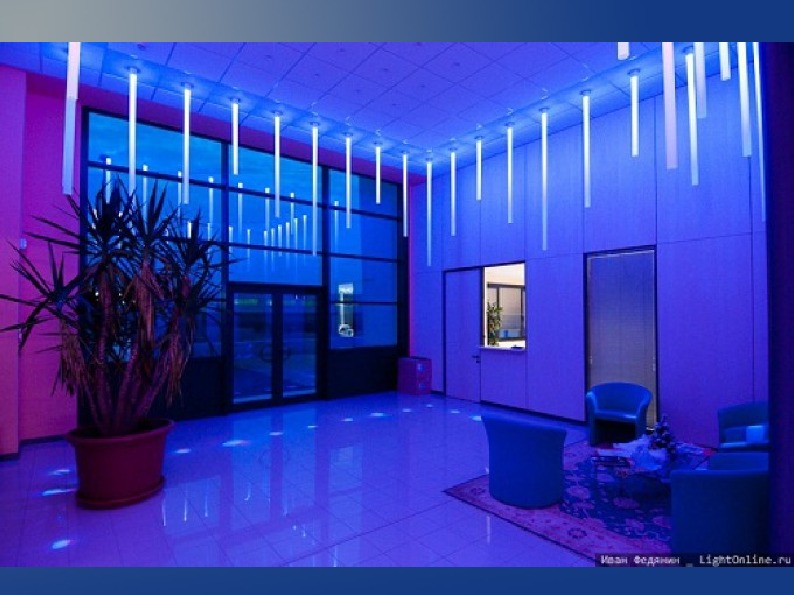
 Main advantages High luminous efficiency. Modern LEDs are on par with sodium LEDs in this parameter. gas discharge lamps and metal halide lamps, reaching 150 Lumens per Watt. High mechanical strength, vibration resistance. Long service life - from 30,000 to 100,000 hours (when working 8 hours a day - 34 years). The spectrum of modern LEDs can be different - from warm white = 2700 K to cool white = 6500 K. Low inertia - they turn on immediately at full brightness, while mercury-phosphorus (fluorescent-economical) lamps have a turn-on time from 1 second to 1 minute , and the brightness increases from 30% to 100% in 3 -10 minutes, depending on the ambient temperature. The number of on-off cycles does not have a significant effect on the service life of LEDs. Low cost indicator LEDs, but relatively high cost when used in lighting, which will decrease with increased production and sales. Safety. Insensitivity to low and very low temperatures. Environmental friendliness - absence of mercury, phosphorus and ultraviolet radiation, unlike fluorescent lamps.
Main advantages High luminous efficiency. Modern LEDs are on par with sodium LEDs in this parameter. gas discharge lamps and metal halide lamps, reaching 150 Lumens per Watt. High mechanical strength, vibration resistance. Long service life - from 30,000 to 100,000 hours (when working 8 hours a day - 34 years). The spectrum of modern LEDs can be different - from warm white = 2700 K to cool white = 6500 K. Low inertia - they turn on immediately at full brightness, while mercury-phosphorus (fluorescent-economical) lamps have a turn-on time from 1 second to 1 minute , and the brightness increases from 30% to 100% in 3 -10 minutes, depending on the ambient temperature. The number of on-off cycles does not have a significant effect on the service life of LEDs. Low cost indicator LEDs, but relatively high cost when used in lighting, which will decrease with increased production and sales. Safety. Insensitivity to low and very low temperatures. Environmental friendliness - absence of mercury, phosphorus and ultraviolet radiation, unlike fluorescent lamps.
 Disadvantages The main disadvantage is high price. The price/lumen ratio of ultra-bright LEDs is 50 to 100 times greater than that of a conventional incandescent lamp. However, at the beginning of 2011 they already appeared on sale LED bulbs at prices (per lumen) competitive with compacts fluorescent lamps. The LED supply voltage is significantly less than the supply voltage of conventional incandescent lamps. Therefore, LEDs are connected in series or use voltage converters Low temperature limit: High-power lighting LEDs require an external heat sink for cooling because they have an unfavorable ratio of their size to thermal power output (the physical size of LEDs is small with high power dissipation) and cannot dissipate as much heat how much is emitted (despite even higher efficiency than incandescent lamps).
Disadvantages The main disadvantage is high price. The price/lumen ratio of ultra-bright LEDs is 50 to 100 times greater than that of a conventional incandescent lamp. However, at the beginning of 2011 they already appeared on sale LED bulbs at prices (per lumen) competitive with compacts fluorescent lamps. The LED supply voltage is significantly less than the supply voltage of conventional incandescent lamps. Therefore, LEDs are connected in series or use voltage converters Low temperature limit: High-power lighting LEDs require an external heat sink for cooling because they have an unfavorable ratio of their size to thermal power output (the physical size of LEDs is small with high power dissipation) and cannot dissipate as much heat how much is emitted (despite even higher efficiency than incandescent lamps).
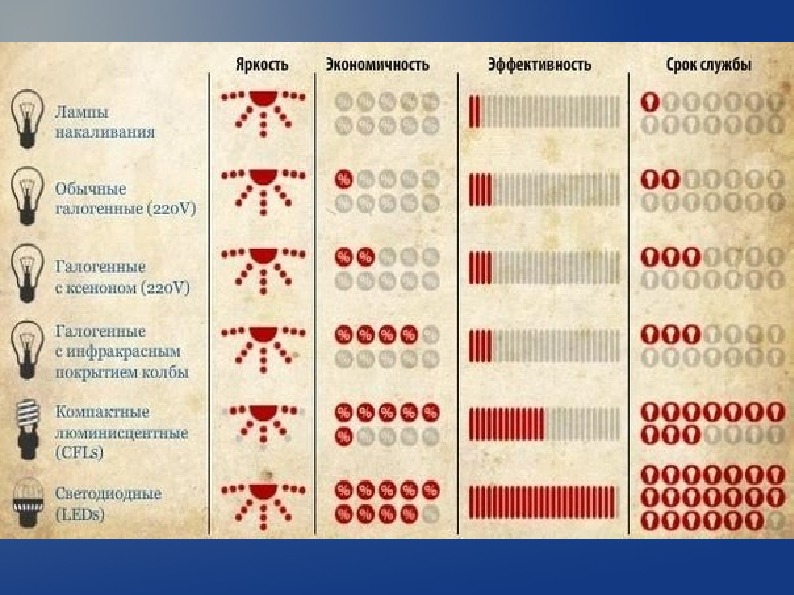
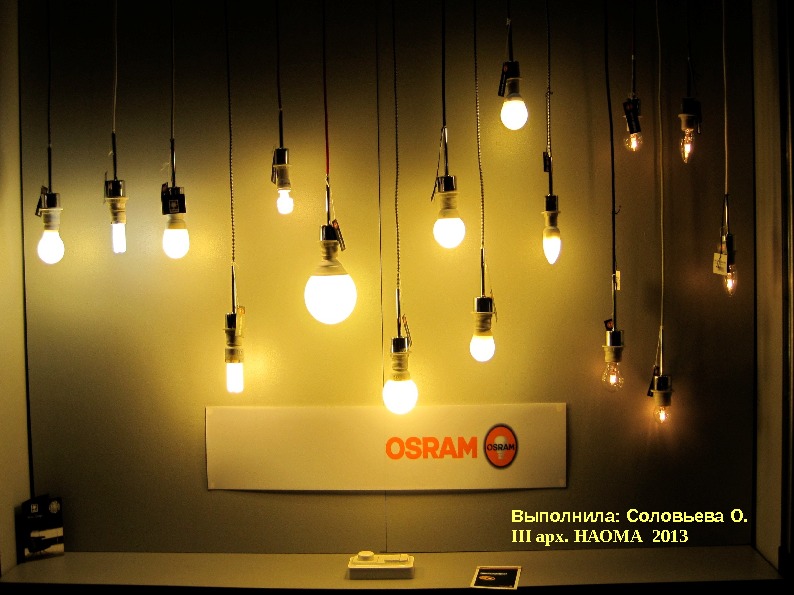 Completed by: Solovyova O. III architect. NAOMA
Completed by: Solovyova O. III architect. NAOMA




